Podcast of Percy Smythe's WWI Diary
Early in 2016 we were approached by Phil Mannell from WWI Digger Stories asking if he could use Percy's diary for his podcast series. He had recently completed the diary of Len Jones also from the 3rd Battalion and we were delighted that he had chosen Percy's story for his second series - it adds a whole different dimension to the prose when read aloud.
I think Phil has done a sterling job without professional equipment or monetary incentive so please leave a review on his iTunes page. Enjoy.
6 Bob a Day WWI Digger Stories
The other very impressive element to these podcasts is that Phil researches any other diggers mentioned in the yarns and gives a brief overview of their lives and service history. The following information is courtesy of Phil.
Episode 2.1, “Build up that chest.” Listen
Major RC Dawson is Major Ross Campbell Dawson of the 1st Battalion, AIF. He suffered a bullet wound to the back of his head during the Gallipoli landing and was evacuated four days later. He was returned to Australia in January 1916., also suffering from neurasthenia (shell shock). Dawson was married and lived at Roseville, NSW. He was born 14 November, 1884 and died 22 August, 1947.
Les Poyitt is probably Leslie Poyitt a postal assistant from Balmain, NSW who was born at Fitzroy in Victoria. Poyitt was in the 56th Battalion when he was wounded at Fromelles on 20 July 1916 and died five days later in hospital at Boulogne. Why I say “probably” is that the time frame does not fit, the Poyitt that died at Fromelle had already embarked for overseas, but the occupation fits. Perhaps Percy had the date or the man mixed up, or there are two Les Poyitts!
“Dubbo” Sharpe is Private 2374 later Gunner Edmund Sharpe of the 3rd Artillery Brigade, a single farmer from Pine View via Dubbo. Dubbo was not born at Dubbo, he was born at Gulgong about September 1892. He is later in the 55th and 5th Pioneer Battalions.
Bob Avant is Private later Sergeant Robert Avant was a single clerk from Sydney and supposedly born at Cootamundra, NSW. His real name is Ulysses Grant Kibby and I suspect he was born in the United States in 1882.
2nd Lieutenant Smythe is Leo Clarke Smythe born at Lismore, NSW on 28 April 1895 and was a single bank clerk from Marrickville. A reservist officer when the boys met him, he enlisted formally on 9 February, 1916 and served in the 45th Battalion. He was wounded by an accidental explosion of a grenade during a training exercise in March 1917 and again at Messines Ridge on 7 June 1917 by a machine gun bullet to the wrist. Toward the end of the war he was accepted by the AFC for pilot training. He is not related to the boys. He died in 1947.
Staff McKenzie is Trooper 810 John Stafford Mackenzie, single works overseer from Wee Waa, NSW, born about 1887 at Alexandra, Victoria. He saw 5 months on Gallipoli before evacuation with gastritis. He enlisted in the Light Horse, with the 7th LHR as well as the 12th, but later was a 2nd Class Air Mechanic of the 68th and 2nd Squadrons Australian Flying Corps. After the war he returned home lived in Albury NSW in 1943 with Olive May McKenzie who he had married in Sydney in 1927 and passed away on 6 March 1956.
Alf Chapman is Corporal Alfred Alexander Boxall-Chapman of the 3rd Battalion and later of the 2nd Australian Flying Squadron. He was born at Jerilderie, NSW in October, 1889. He was a single engineer on enlistment. Alf was returned to Australia in March 1916 with a cataract in his eye before re-enlisting. It doesn’t look like he ever flew planes!
Wickham is 2464 Private Alexander Wickham, later of the 45th Battalion who is a single miner from Wallsend NSW and born at Mt Kembla in 1894. He was in St Patricks Hospital Malta with influenza, wounded twice during the war and returns to Australia.
Sergeant Hockings is Private later Corporal Albert Charles Hockings, a married painter from Canterbury, NSW. He was born in Devonshire, England in 1880 and was a Boer War veteran. He was returned to Australia with shell shock and rheumatism in early 1916. He had been buried during a bombardment on Gallipoli.
Corporal Webb is Private, later Corporal Henry William Webb, a single blacksmith from Mosman, NSW born about March, 189. He was previously in the AN & MEF, the force that took New Guinea from the Germans in 1914.
Joe Sheen is Joseph Reginald Skeen a single shunter from Blackheath. He was born in September, 1891 and would serve in the Imperial Camel Corps. His only major injury in the war is from a camel bite on his private parts!
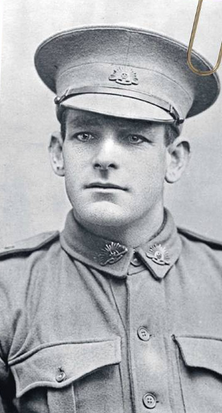
Charlie Bruce is Private, later Lieutenant 1390 Charles John Bruce, a single plumber from Blakehurst, NSW. With reinforcements for the 19th Battalion, he embarked on the Ceramic on 25 June, 1915, a couple weeks before Percy leaves on the Orova. He was born at Glasgow, Scotland about 1880. He was later transferred to the 2nd Pioneer Battalion.
Not a soldier: Jack Elliott will become Percy’s frequent correspondent through most of the diary. John Bramwell Elliott was born at Hurstville NSW on 11 September 1894. Jack was firmly against the war, a pacifist and a conscientious objector. He was living in Taree, with his address given as “Church of Christ, Taree” when he appeared before the Court for refusing to take the oath of affirmation. The case was heard on 13 November 1916 and Jack was sentenced to four months jail with hard labour. That evening in the police cells, before being transported to Maitland Jail, Jack swore the oath and was immediately released. Although Percy and Jack were extremely religious and had attended the same church, becoming very good friends, this difference of opinion on Christianity and the war came between them. Jack worked most of his life as a train driver on the NSW North Coast. He married shortly after the war and had two children. Tragically, Jack suffered a heart attack and died while swimming at Newcastle on 31 January 1950.
Episode 2.2 “Crimed for what?” Listen
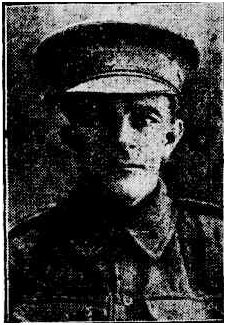
“Winnie Shearston’s brother” is either Arthur William or Horace Shearston of Manly, NSW. Arthur was killed at Lone Pine and Horace was killed at Moquet Farm. There were only the three siblings in the family. Horace had also served in New Guinea in 1914.
Wilson is Lieutenant later Captain Harry Lionel Wilson who was born at Bethanga, Victoria in 1880. He was a married telegraphist on enlistment. He was wounded three times.
Tyson is Lieutenant later Captain James Gordon Tyson. He was born in Chatswood, NSW on 6 February 1885. His brother was a soldier in the 19th Battalion. Both men were killed at Bullecourt on the same day.
Peacock is Private 2457 Richard Charles Peacock a single farmer from Morpeth, NSW. He was later a driver with the army ordinance corps.
Weinrabe is Private 2494 Lewis Byron Weinrabe, a single labourer from Kensington, NSW. He was born in 1894 at Paddington, NSW. Later moved to the 55th Battalion, he was wounded twice in 1917.
Jack Morrison is probably Private 2381 Cedric Stanley Morrison, a single clerk from Lewisham, NSW. He wins a military medal at Dernicourt in April, 1917.
Dorrington is Private, later Lieutenant Frank Roy Dorrington, a single bank clerk from Broke, NSW. He was born at Redfern, NSW in 1893. Later transferred to AIF Headquarters, he wins a Meritorious Service Medal.
Hill is Private, later Lance Corporal, Esmond Fenwick Du Rien Hill, a single bank clerk from Grafton, NSW. Poor bloke, his mother must have had it in for him, “du rien” means it’s nothing. He was born in 1893 at North Sydney. Later in 7th Field Company Engineers. He was wounded in 1916.
Boyd is Private 2330 Jack Crawford Boyd, later of the 5th Pioneer Battalion, a single engineer from Sydney, NSW. He was born at Belfast in June 1895. He nearly died from enteritis at Gallipoli and pneumonia afterwards.
Brown is possibly Private, later Sergeant 2448 Albert Ernest Brown, single labourer from Wentworthville, NSW.
Blackett is probably Private 2383 John Stevenson Blackwood a single waiter from Randwick, NSW. He was born at Sligo in Ireland on 8 October, 1896. He was a very young Irish immigrant!
Arthur Ide is Private 2488 Arthur Ide, a single cook from Paddington NSW. He was born at Bega NSW about 1885 and died on 22 August 1960. He returned to Australia in February 1916 and developed epilepsy after his head wound.
Meale is Private 1402 William Alexander Meale, a single dairy hand from Croydon, NSW. He went into the 19th Battalion with Charlie Bruce and was wounded once during the war. He was born at Erskineville, NSW in 1895 and died in March 1957.
Howie is 2nd Lieutenant, later Captain 2444 Clarence Malcolm Howie. He was born in Sydney on December, 6, 1894. He will go on to win a Military Cross in 1918 and re-enlists in WW2.
Woods is Company Sergeant Major 2442 William Woods who was a married music hall artist, born in England in 1887.
Thornthwaite is Private 2462 Ernest Hubert Thornthwaite, a married farmer from Marrickville, NSW. He was born about 1886. He later moves to the 55th Battalion. He suffered a bad gunshot wound to the foot at Fromelles and was sent home in late 1916.
Howard is Private, later Sergeant 2445 Henry George Howard, a married labourer from Lidcombe, NSW. He was born at Wakefield in England about 1884 and his wife was still living in London when he enlisted. Another 55th Battalion man.
Ralph Dixon is Lance Sergeant 886 Ralph Taylor Dixon, a single carpenter from Narrandera, NSW. He was born at Waradgery, NSW about 1894. Ralph was killed in action on 24 May, 1915 during a minor Turkish attack.
Rixon was Private 513 William Keith Rixon, a single telegraphist from Bulli, NSW. He was born at Murrurundi, NSW about 1891. He was killed in action on 13 June 1915 and has no known grave. Vern Smythe confirms that he was shot while trying to shoot an enemy sniper.
Lorrie Maloney is the twin of Elsie Maloney, whom Bert calls "The One and Only" or TOO for short. He was not accepted into the AIF until 1918.
Du Prat is Private 2346 Jean-Francois Duprat, a single builder from Sydney City. He was born at Limoges, France about 1878. He was a French army veteran before emigration. He ends up in the 1st Australian Corps Salvage Section.
O’Connor is Lance Corporal 2456 John Levy O’Connor, a single tram driver from Edgecliff, NSW. He was born at Richmond, Victoria in 1884. He was wounded at Gallipoli and was later transferred to 1st Australian Field Butchery and then to the 20th Battalion with whom he was wounded twice more.
Drain is Private 2343 Edward Drain, a single grazier from Burraga, NSW. He was born about 1889. Drain is fatally wounded at Gallipoli and dies on a hospital ship Gascon on 11 September, 1915. He was buried at sea.
Davies is Private 2340 William Davies, a married cook from Pyrmont, NSW. He was born in Sydney about 1878. He will also be transferred to the 55th Battalion. He had shell shock after Fromelle.
Creech is Private later Lance Corporal 2338 James Joseph Creech, a single blacksmith from Young NSW, where he was born about 1893. He was wounded twice, once on Christmas eve, 1916. Creech will return home with an English nurse, Norah Ellender, as a wife. He died on 17 September 1939 at the Randwick Military Hospital.
Kirkland is Colonel George Kerry Kirkland, the Commandant of the Liverpool Camp until he was relieved of this duty amidst scandal and numerous complaints by the trainees in January 1916. He was born at Derby, England on 5 May 1863 and was a married electrical engineer from Longueville, NSW. After Liverpool, he was transport officer on troop ships. He died in 1937.
Jack Parker is most likely 2nd Lieutenant John Parker of the 30th Battalion. He was killed at Fromelles on 20 July 1916. He was a Lismore boy born at Kiama, NSW in July 1895 and an assurance clerk on enlistment.
Episode 2.3 “Bert at ANZAC” Listen
Sergeant Cavill is Sergeant 1483 Walter William Cavill who was born at Delegate, NSW in 1878. He was a married engineer from Portland, NSW on enlistment. He was a Boer War veteran who served 12 months in the NSW Lancers. He has no known grave.
Company Sergeant Major MacGregor is “A” Company Quarter Master Sergeant 1481 Donald Neil MacGregor, a single school teacher from Mildura, Victoria. He was born at Walkerston, Queensland in 1887. He was killed at Quinn’s Post. His letters are kept at The Australian War Memorial.
Colonel Owen is Lieutenant Colonel Robert Haylock Owen, the first commanding officer of the 3rd Battalion. He was married on enlistment and was born on 7 January, 1862 at Wollongong, NSW. He had served in the Sudan Campaign in 1885 and The New Zealand contingent in the Boer War. His son also served in the 3rd Battalion and was killed in 1917. The Colonel was wounded on 22 June, 1915 and was returned to Australia in 1916. Later, he moved to Barnstaple, England where he died 5 April, 1927.
The Brigadier is Colonel Henry Normand MacLaurin, a single Barrister from Sydney, NSW. He was born in Sydney on 31 October, 1878 and was educated in Scotland and the University of Sydney. He had been an officer in a reserve regiment, the NSW Scottish Rifles since 1900. He was killed at 3.10PM on 25 April, 1915 and was posthumously promoted to Brigadier General. His brother Charles was a Lieutenant Colonel and medical officer in the AIF.
The Brigade Major is Major Francis Duncan Irvine, a British regular officer previously with the Royal Engineers. He was killed near the 3rd Battalion headquarters at Steele’s Post, about 200 metres from Brigade HQ 10 minutes before the Brigadier. It has been suggested that the same sniper got both men. Irvine was born 20 January, 1875 at Waltair, India and was married to Emily who was possibly living at Bondi, NSW while her husband was overseas.
Major Brown is Ernest Samuel Brown, a Captain on enlistment, later promoted to Lieutenant Colonel and appointed commanding officer of the 2nd Battalion. He was born about 1876 and later killed during the battle of Lone Pine on 6 August, 1915. His letters and a few other items are held by the Australian War Memorial in Canberra.
Elbel is Private 1135 Henry Edward Elbel, a single labourer, born at Carlton, Victoria in March, 1892. A model soldier, he was not. He was hospitalised for alcohol poisoning in September 1915, also contracted Syphilis and was absent without leave at least once. Discharged medically unfit in 1916, he later settled in Rockhampton, Queensland where he died on 9 April, 1938.
Cox is Private 1113 Rodger Cox, a single postman from Grafton, NSW where he was born about January, 1890. He is buried near where he was killed at Shrapnel Valley Cemetery.
Episode 2.4 “Through the heads” Listen
Old Williams is probably Robert Albert Williams, a married labourer from Enmore, NSW. He was born about 1883. Is 37 old?
Kinsella is Private 2355 Grattan Kinsella, a single labourer on enlistment. He was born on 26 September, 1891. He had an interesting military career, being sent home with influenza in January, 1916, he was returned in the 22nd reinforcement, disembarking in France 11 months later. Kinsella was one of only 19 men in the 3rd battalion to be taken prisoner when he and 10 others were surprised while cooking dinner in an isolated outpost. He gets home and lives at Coogee, NSW, dying in 1948.
Le Clerc is Private 2361 Harry Oswald Le Clerc, a married plasterer. “Cheery” as he was known, was born in Sydney in 1891. Cheery had four children and not much luck. Sick at Gallipoli and wounded ay Pozieres, he lost his life on 9 August, 1918 and his wife lost hers on 25 September 1918. Poor kids.
Harwood is Private 2360 Ralph Osborne Harwood, fitter from Wickham, NSW. He was born at Liverpool in England in June 1895. He was killed at Gallipoli on 3 November, 1915.
Bassett is Private, later Driver, 2465 Otha Eveleigh Bassett, a single farmer from Condobolin. He was known as “tiny” Bassett and was killed at Fromelles before the battle on 3 July, 1916. He was one of the first men killed in France in the 3rd Battalion. Tiny was a driver in the transport section, but was out in no mans land helping B Company when they were killed during a “friendly” artillery barrage that the Battalion officers were not properly notified about. Tiny has no known grave.
Duggan is Private 3354 James Daniel Duggan, a single labourer from Balmain, NSW, born in 1890. Duggan becomes a lewis gunner. He was shot in the head by a sniper in October 1916 at Ypres.
Colonel Wallack is later Brigadier General Ernest Townshend Wallack. A Boer War veteran with the 2nd Tasmanian Bushmen, he was born in England on 9 August, 1857.
Rob Winters is probably Private later Lance Sergeant 2474 Robert Richard Winters of the 4th Pioneer Battalion, a single carpenter from Kogarah. He was born at St Peters, NSW in June 1894.
Episode 2.5 “Baksheesh” Listen
The man who fell overboard is difficult to identify but I suspect he is Private Robert Shaw of Bondi, NSW.
Cherry is Private 2336 Oliver James Cherry, a married butcher from Newcastle, NSW on enlistment. He was born at Wallsend, Tasmania in 1891. He would end the war with the Australian Flying Corps.
Allthorpe is Private 2423 Frederick William Allthorpe. He was born at Stawell, Victoria on 22 November 1893 and was a single labourer. He spent one month at Gallipoli, being evacuated with influenza in October 1915. Does he “go MAD over a girl”? He escaped from confinement in England for 3 days in May 1916 and he was sent home on 24 June 1916 due to “dysentery and mental”. He then tried to re-enlist in 1917, stating his next of kin to be Mrs Dorothy Elizabeth Allthorpe from London. He then did some home service in 1918 when he also went AWL and in September 1919, he applied for passage for his wife to travel to Australia. He was living in Carlton, Victoria in 1944 and died on 1 August 1959.
Osborne is Private later Sergeant 2414 Frederick Robert Osborne of the ANZAC Light Railway, a single baker from Drummoyne, NSW, where he was born about March, 1892. He returned to Australia.
Carroll is one of two men. Either, Private 2389 Gerald Carroll goes on to become the Regimental Quarter-Master Sergeant. He was born in New Zealand in 1883 and dies at Port Macquarie, NSW on 3 August 1953. The other is Private 2471 Rupert Gregory Carroll who was born on 31 March 1893 at Paddington, NSW.
Campbell is also one of two men. Most likely, he is Private, later Sergeant 2388 Harold Campbell is the subject of a book “Four Australians at War” by grandson, Maurice Campbell, and Graeme Hosken. He was born at Wellington, NSW in 1893 and was a single farmer on enlistment. Less likely, he is Private 2334 James Campbell who was born at Newcastle, NSW in 1891.
Dudley Blanch is Private 2384 John Dudley Blanch. He was a Kiwi, born at the other Wellington about 1894. On enlistment, he was a married tally clerk from Coffs Harbour, NSW. He died on 2 December, 1915 and is buried at Shell Green Cemetery.
George Schroder is Private, later Warrant Officer 2438 Charles George Schroder, a single bookkeeper from Mayfield, NSW. He was born at Bellingen, NSW about 1893. Schroder will go home with a Meritorious Service Medal and a French Croix de Guerre. He also broke his leg playing cricket in France!
Charet is Private later Corporal 2450 Bruce Frederick Charet, a single book merchant from Mosman, NSW and born in 1895. He later moved to the 13th Field Artillery Brigade. He was wounded twice during the war.
Episode 2.6 “To Gallipoli” Listen
Robertson is Private 2403 Archibald Robertson, a single groom possibly from Hay, NSW. He was born in Melbourne, Victoria in 1878. He will be wounded in August 1916 and killed on 24 June 1918.
Board is Private 2406 Thomas William Burt Board, a single packer on enlistment. He was born at Lidcombe, NSW in 1892. He was killed at Pozieres.
Lax is Private later Lance Corporal 2454 Fred Lax, a fitter from Wickham, NSW. He was born at Liverpool in England in 1890. Fred has a bad time on Gallipoli with illness, and killed at Pozieres.
Episode 2.7 “Dead Man’s Gully and other charming places” Listen
The Brigadier General is Sir Neville Maskelyne Smyth VC. nicknamed “The Sphynx” is the Commanding officer of the 1st Australian Infantry Brigade. He won the VC in the Sudan War in 1897. His cousin was Robert Baden-Powell of scouting fame. The Sphynx was born on 14 August 1868. His high regard for his men was matched by their high regard for him.
Eric Conolly is Private 2337 Eric Richard Conolly, a single assistant shire clerk from Darlington Point, NSW. He was born at Rockdale NSW in 1894 and was a lewis gunner. He was hospitalised for mumps at Gallipoli and killed at Pozieres. He has no known grave.
Barber is Lieutenant George Foster Barber, a married contractor from Marrickville, NSW. He was born on 23 May 1872. He returns to Australia in early 1917.
Frost is Private later Lance Corporal 2626 John Herbert Frost. He was born at Cootamundra NSW in 1894 and was working as a labourer on enlistment.
Gardiner is Private later Corporal 2452 William Sheridan Gardiner, a single farrier from Narrandera, NSW. He was born in Cootamundra NSW on 10 February1889. He goes home and serves in the 11th Garrison Battalion during WW2, dying on 21 October 1943 of illness.
Roach is Private 2458 James Alfred Roach, a single clerk from Narrandera, NSW, where he was born about 1892 and was killed by a shell at Pozieres on 23 July 1916. He has no known grave.
Marshall is Lieutenant John James Marshall, later a Captain in the 55th Battalion. He was born at Bexley, NSW in 1891 and was killed on 27 April 1918. Before the war, he served in the reserve 38th Brigade at Kogarah, NSW. He was also wounded at Polygon Woods in October, 1917.
Dent is Private 2498 William Thomas Dent, single jeweller from Vaucluse, NSW. He was born at Balgownie near Wollongong, NSW on 29 November 1892. He later serves in the 14th Field Company Engineers and the 5th Pioneer Battalion.
Barry is Private 2382 John Barry, a single clerk from Randwick. He was born at Raymond Terrace NSW about 1882 and died on 3 June 1941. He later transfers to the 55th Battalion.
Sergeant McGregor is Sergeant later Lieutenant 1156 Roy McGregor, alias John Keith Williams, he was a single commercial traveller on enlistment. He won a DCM two days after the Gallipoli landing for bringing forward much needed ammunition under heavy shellfire. He was later transferred to the Camel Corps.
Parker is Private, later Corporal, 1414 Charles Samuel Parker, a single farmer from Jervis Bay, NSW. He was born at Birchup, Victoria about 1890. He does not come home, getting killed at Ypres in October, 1917 after three previous woundings, two at Gallipoli and again at Pozieres.
Episode 2.8 “Chats, Beachy Bill and other nuisances on Gallipoli” Listen
Duggan is Private 2345 John Robert Duggan, a single brick layer from Alexandria, NSW where he was born about 1894. He died of wounds received at Gallipoli on 6 September 1916.
Daly is Private 2501 Augustine Daly, a married school teacher from Goulburn, NSW. He was born at Mudgee, NSW in 1863 and put his age down to enlist. He died of pneumonia on board the Orsova on 2 August 1915 and was buried at sea. Six of his sons also served in the Great War, one of which, Private Hubert Aloysius Daly of the 18th Battalion was killed in action.
Eric Wade is Private, later Lieutenant 1200 Eric Eratt de mestre Wade, a single mercer from Kendall, NSW. He was born at Walcha NSW on April 1895. He served in the 1st Light Horse Regiment and the 8th Training Squadron Australian Flying Corps and re-enlisted in WW2.
Ingram is Private 2354 William Leslie Ingram, a married carpenter born at Nth Sydney about 1888. He was later wounded at Passchendaele and died 20 April 1954.
Ryan is Private 2373 Patrick Ryan, a single labourer from Berrigan NSW. He was born at Strathmerton, Victoria about 1891. He was later in the 1st Trench Mortar Battery and will return home to Australia after the war.
Lines is Private Frederick Augustus Lines, a single man on enlistment but married to an English girl before returning to Australia. He was born on 21 January, 1892 at Newtown NSW.
Episode 2.9 “Comin’ thro’ the rye … at Malta” Listen
Lord Methuen is Governor of Malta, Field Marshal Paul Sanford Methuen who was born at Wiltshire, England in September 1845 and fought in several wars, mostly with distinction. He died in 1932. Lady Methuen is Lady Mary Ethel Methuen.
Fitton is Sapper later Lieutenant Albert Henry Fitton of the 1st Signal Troop a single telegraphist from Banksia NSW. He was born at Surry Hills NSW in late 1889. He was admitted to St Johns with jaundice on 27 October 1915. He was a pilot with the AFC at the end of the war. He died 12 May 1957.
Tom Martin is Private later Sergeant 2245 Harold Thomas Martin, a single carpenter from Gladesville, NSW. Tom was born about January 1892 at Hunters Hill, NSW and did return home, dying 13 November 1972. He was in the 2nd and 1st Pioneer Battalion.
Wall Park is Private 2253 Wallace Park, a single builder from Gladesville. Wal was born at Ryde NSW in August 1890. He was serving in the 2nd Battalion when he was killed at Lone Pine.
Nurse Kerr is Constance Kerr born at The Breck, Triangle, Halifax, England about 1887. She served in Malta from September 1915 until March 1916, then in France until December 1916 when her service was terminated.
Episode 2.10 “The Maltese Tourist” Listen
Bill Mallon is Private 2869 William James Mallon, a single labourer from Jerilderie. He was born at Urana, NSW in 1891. Bill is injured and dies of his wounds on 11 April 1917.
Jim Coleman is Private 2798 James Gordon Coleman, a single butcher from Jerilderie, NSW, where he was born. He and Bill Mallon enlisted on 23 July 1915, embarked together on the Argyllshire on 30 September 1915 and served together in 10th Field Artillery Brigade. Jim returns to Australia and died on 28 May 1963.
Ernie Sadler is Private 2386 Ernest Roderick Sadler, a single rail worker from Taree, NSW. He was born in Sydney in 1890. Ernie dies of disease on 18 October, 1918 and is buried at the Damascus Commonwealth War Cemetery in Syria.
Ziegenbein is Private, later Sapper 3973 Frederick Julius Bernard Ziegenbein. He was a single telegraphist from Cundleton, NSW, born at Newlands, Cape Colony, South Africa about 1885. He enlisted in the 2nd Battalion but ended up in 1st Division Signal Company before returning home early in August 1916. This man served in a Boer War volunteer detachment, Driscoll’s Scouts for seven months (Service Number 30075) and also the Cape Town Highlanders for six months. There is doubt this man was officially a Boer War Veteran as he was only 17 when that war ended. In this war he was noted to be an excellent signaller, however, he was sent home after the AIF received a report from Taree Post Office outlining his open hostility to the war effort. His CO, Major Gordon, had kept him under surveillance while in the Signal Company and thought he was proficient but he did wander off alone a lot and had no friends in the unit. Unfair? Maybe, who knows? Major Gordon and his superiors obviously did not want to risk the kind of damage this guy could have caused if he did decide to pass on information. Still, was a negative telegram from Taree sufficient evidence?
Kibble is Private David Joseph Kibble, a single farmer from South Australia. He was born at Harrow, Middlesex, England, where his Mum still lived, about 1897. He was taken on strength to the 10th Battalion on Gallipoli but sent home in March 1916. He went back to France in December 1916 and after further debility he was once again sent home to Australia in March 1918. Kibble died on 14 August 1931 and is buried at Adelaide, SA.
Frank is Private 238 Clarence Edward Frank, a single labourer from Newcastle, NSW. He was born at Warwick, Qld about 1893. He was at Malta with dysentery. He was killed at Pozieres on 23 July 1916 and has no known grave.
Penny is Private later Corporal 2415 Alec Gordon Penny, a single grocer from Erskineville, NSW. He was born at Margate, England about 1892. Penny is later in the 55th Battalion and he comes home with a Distinguished Conduct Medal in 1919. Here is what he did to win his DCM, quoting the citation, “For conspicuous gallantry and devotion to duty during a raid. He successfully rushed an enemy machine gun post with his section, himself bayoneting three of the garrison. Inspired by his skill and courage, his party worked along either flank and accounted for all the enemy in that part of the trench. On the signal being given to withdraw, he got all his men back to the lines, having contributed greatly to the success of the raid.” This was at Sailly-le-Sec on 4 July 1918. He hoisted the German machine gun onto his shoulder and brought it back to his lines as a souvenir.
McNulty is Private 2432 Robert John McNulty, a single carter from Bondi, NSW. He was born at Emmaville, NSW about 1893. He was killed on 28 September 1915 and is buried at Shrapnel Valley.
Episode 2.11 “News of Gallipoli” Listen
Bishop is Private 2492 William Robert Bishop, a married contractor from Arncliffe, NSW. He was born at Stawell, Victoria about 1875. He was wounded on 15 November, 1915 and died the next day. Bishop had at least one daughter, Dorothy.
Foley is Private 2502 Peter John Foley.
Hart is Private 2495 Frank Herbert Hart.
Hicks is Private 2429 William James Clifford Hicks.
Gimbert is Private, later Corporal 1123 Robert William Robert Gimbert, a single labourer from Newcastle, NSW. He was born at Murrurrundi, NSW about 1889. He was later in the Army Provost Corps. He was at Malta with Pleurisy. He married an English girl and stayed in England for some time before returning home to Australia, passing away on Christmas Day, 1959.
Episode 2.12 “A walk in the desert” Listen
“Old” Davis is probably 35 year old, Private 2341 Robert Davis, a single seaman from Newtown NSW. He was born at Stanford Rivers Essex in England on 5 February 1880. At 15, Davis joined the navy and stayed in it for 11 years. I’m not sure when he emigrated to Australia. He enlisted in May 1915, did not make it to Gallipoli in time but would become a Prisoner of War at Fromelles while serving in the 55th Battalion. He was repatriated home after the war and a short stay in England.
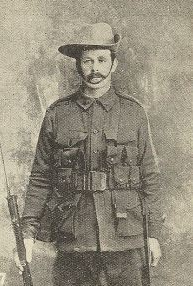
Butcher is Private, later Lieutenant 2333 William Eneras Butcher, a single labourer from Manly, NSW. He was born in Launceston, Tasmania on 4TH July 1881. Later in the 1st Trench Mortar battery he was mentioned in dispatches in 1916. He returned to Australia after the war passing away at Balgowlah NSW on 2 October 1951.
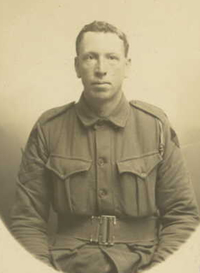
Glenday is Private later Company Sergent Major 2656 James Glenday, a single commercial traveller from Carlton, NSW. He was born at Coupar Angus in Scotland on 26 October 1887. He was in the 17th Battalion, wounded twice in action and returned home. James married Eva Munday in 1921, had 4 children, remarried after his wife died and passed away on the 8th June 1955 at Hurstville NSW. He is buried at Woronora Cemetery.
Drewe is Private later Sergeant 2480 Francis Clifford Drewe, a single draftsman on enlistment. He was born in Liverpool, or nearby Egremont, England about 1891. He was wounded twice during the war, including at Fromelles with the 55th Battalion and returned to Newcastle afterwards, dying 25 February, 1942. He was married with one daughter.
Ewins is Private later Lieutenant 2390 Harold Egbert Ewins, a married electrician from Tamworth, NSW. He was born in Fiji on 26th July 1881. He finished the war in the 1st Machine Gun Battalion and was mentioned in dispatches. He returned home and passed away at Carlingford NSW on 16th July 1976.
Groves is Sergeant 1502 Henry William Groves, a married seaman from Redfern, NSW. He was born about 1878 at Hackney, England and had served 20 years in the Royal Navy. Later in the 55th Battalion, he would return home in October, 1917 and passed away on 2 October 1921 and is another buried at Woronora Cemetery.
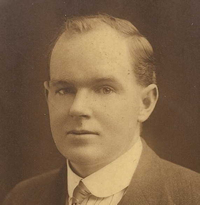
Siddins is Corporal 2227 Norman Macquarie Siddins. He is a single traveller and accountant from Leichhardt, NSW, where he was born in 1893. He would return home with a Meritorious Service Medal in 1919, marry Margaret in 1924 and die on 13 February 1928 at Randwick Hospital.
Millard is Private, later Sergeant 3091 James William, actually John Samuel, Millard. He was born at South Melbourne, VIC about February 1893 and was a labourer from Erskineville NSW on enlistment. Millard is wounded in 1918 and returns home.
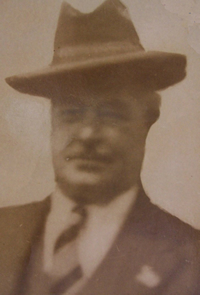
Chantrill is Private, later Company Quartermaster Sergeant 2578 Benjamin Joseph Chantrill, a married ironmonger from Croydon, NSW and was born in 16th March 1875 at Sydney. He would be wounded three times during the war, return home married, had three children and passed away on 27th July 1944.
Captain Edwards is Captain, later Major Arthur Rowland Edwards. He was born in Western Australia (I think) on 29 October 1891. A transfer in from 4th Battalion, he was injured at Pozieres and return home in October 1916. Major Edwards passed away on 10 May 1944 when he fell down a stair case while lighting his pipe at a club in Newcastle, NSW.
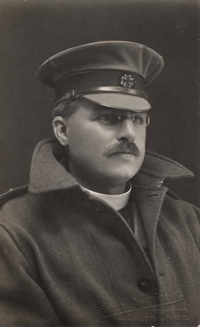
Chaplain McNicol is Captain / Chaplain (4th Class) Donald McNicol a married Baptist Minister from Malvern, South Australia, who was born on 13 September, 1876 in Argyleshire, Scotland. A Boer War veteran who also had served in Gibraltar, he would be the chaplain for the 18th Battalion later but sent home with an undiagnosed illness in late 1916. He died in April 1942 leaving a wife, married daughter and three sons serving in WWII.
Episode 2.13 “Percy gets a stripe” Listen
Captain Simpson is Captain, later Lieutenant-Colonel Adam James Goldie Simpson, a single law clerk and Cambridge Graduate from Hunters Hill, NSW, born 9 March 1888. He had served in a cavalry unit prior to the war. Originally enlisting in the 4th Battalion with his brother, he was transferred to the 56th Battalion when it was formed in early 1916. His brother, George, had been killed at Lone Pine.
Jack Bubb is Corporal, later CSM 1507 Clarence Paul Bubb. A married plumber, born at Geelong, Victoria on 6 January 1892. He was wounded twice and returned home after the war with an MSM. He also re-enlisted in WWII.
Wallace Frazer is most likely Gunner 19068 Albert Wallace Frazer of the 10th Field Artillery Brigade, a single student from Kensington, NSW. He was born near Wellington NSW about August, 1896. He was wounded in June 1917 and was returned to Australia a few months later. He appears to have been still alive in 1969.
Murray-Cowper is Private 1108 James Stewart Murray-Cowper. An engine cleaner from Nowra, NSW, he was born at Euston about 1894. He will be wounded at Pozieres and sent home with shell shock, but also enlists for home service in WWII.
Charlie McDougall is Private, later Driver, 2647 Charles Alexander McDougall, a single labourer from Darlinghurst, NSW. He was born at Jerilderie, NSW in 1893. He returned home after the war.
Mick Taylor is probably Private 2697 Henry Thomas Taylor, also a single labourer from Jerilderie, NSW.
Sergeant Gordon is Sergeant 1090 James Gordon. Jimmy Gordon was born at Wolumla NSW on 26 January 1895. A tough boy whose dad had died in a gold mining accident when he was 1 year old. He was wounded three times at Gallipoli.
Major Price is Major, later Lieutenant Colonel Owen Glendower Howell-Price. He was born 23 February, 1890 at Kiama NSW - one of six brothers. Owen won the Military Cross at Lone Pine and the DSO in France. Four of his brothers were also decorated during the war.
Chaplain McKenzie or “Fighting Mac” became one of the most colourful characters in the AIF. William McKenzie was born in Scotland on 20 December, 1869. He was a married Salvation Army officer on enlistment. Chaplains were not allowed to participate in the fighting but Mac never denied the rumours that he took part in attacks, including once when he led a charge armed only with a shovel. There is much written about Fighting Mac.

Mr Page is 1166 Lance Corporal Clarence Garfield Page. He was born at Woodford NSW in 1895. He was already a war hero by this time, winning a Military Medal at Lone Pine.
Enver is Enver Pasha. He was a leader of The “Young Turks” and minister of War in the Ottoman Empire.
Episode 2.14 “A pretty face like a girl” Listen
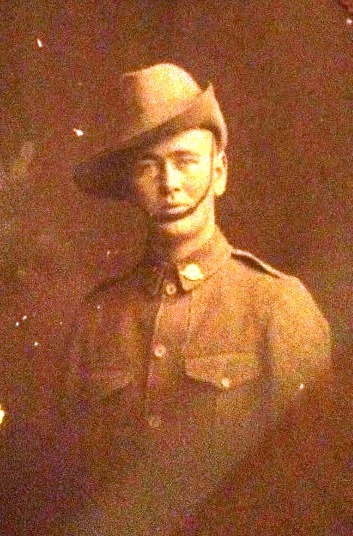
Jim Voss is a very interesting character. Lance Corporal, later Lance Sergeant 1187 James Martin Voss was born in 1894 in German settled Burrumbuttock, NSW. Jim’s dad was born in Schleswig Holstein in 1854 but his Mum was Australian. In late 1916 he was found shot in the head well behind the lines. His father was told by someone in the Battalion that Jim was shot by one of his mates. If so, there is nothing recorded in any notes and the family never received a satisfactory answer. There is some evidence that he may have been taunted for his German heritage.
Lowrey is private, later Lance Corporal 2431 Albert Lowrey. He was born at Dungog NSW in 1893. He returned home after the war.
Osborne brother's is Private 1158 Alick Thomas Osborne, who is a major character in Harry Hartnett’s book, “Over the Top”. “Bazzy”, as he was known, had been wounded at Lone Pine, was later in the 2nd Battalion with Hartnett, returning home in 1919 and dying in 1959.
Ced Wright is Private, later Lance Corporal 1489 Cedric Shipman Wright. He was born in Sydney about 1893 and was a single machinist on enlistment. He re-enlists in WWII (NX17640) after putting his age down 7 years. He was wounded at Passchendaele and returns home in 1919. He was still alive in 1962.
RSM Rudkin is Regimental Sergeant Major 1116 Thomas Sidney Rudkin. He was born in England in 1889. He was disfigured during the war when he was injured three times. An agricultural scientist after the war, he rarely went amongst crowds. In 1950 he was killed when changing a tyre on his car and the jack failed!
Harry Wilson is Private 2262 Harry Wilson, a single painter, born at Murrurundi, NSW about 1883.
Sergeant Major Morris is 1149 George Alfred Morris. He was born at Ultimo NSW in 1889. He won the Military Cross at the Battle of Lone Pine.
Perkins is Corporal 787 Frederick “Perky” Perkins, a single engine driver from Cessnock, NSW. He was born at Slowbridge, Worcestershire, England about 1894.
Rosser is Sergeant 1089 Richard Walters Rosser, a single postal assistant born on 5 March 1894 at Corowa or Holbrook, NSW. He was a Coronation Cadet attending King George’s coronation. He was later killed at Pozieres and has no known grave.
Episode 2.15 “Pity the 9th Battalion” Listen
Geordie Crawford is Private 1331 Samuel Crawford. He is a single miner, born in England about 1888. He ends up in a psychiatric hospital at the end of the war, suffering from delusions and paranoia and was returned to Australia in late 1916.
Porter is most likely, Private 665 Cyril Joseph Porter. He was a single station hand born about 1893 at Junee NSW. He returned in December 1917.
Percy Morgan is Private 1460 Corporal Percy Morgan, a single rural worker, born Hounslow, England in April 1893 and emigrated to Australia in 1911. He was wounded at Gallipoli at the same time as Bert Smythe and evacuated to England. The Smythe’s became quite close to Perce’s mum, Lizzie, staying with her whilst in London and she acted as a post office for sending and receiving mail for them. Bert referred to her as “Mumsey” in his last letter. link
The Duckworths are brothers, 3042 & 3043 John and Horace Victor Duckworth, both born at Geelong, Victoria. John is the elder of the two, born in 1892, while Horrie was born on 2 July 1897. John was a single dental mechanic and Horrie a single carpenter on enlistment. Both boys were wounded and returned home after the war, Horrie as a Lance Corporal. Horrie served again in WWII and suffered a fatal head injury at Tuena near Orange, NSW on 30 December 1946 while diving into the Fish River. He was manager of the Orange Gasworks at the time and was married with one surviving child.
Nagle is Private 2185 Francis William Joseph Nagle a single saddler from Warren, NSW where he was born in 1894. He was wounded in May 1916 and then again suffers shell shock at Pozieres returns home in February 1917 and passes away in 1973.
Wells is probably Corporal 1137 Matthew Ezekiel Wells. He was born at Junee NSW on April 13, 1892. He was a single labourer. He would win a Belgian Croix DeGeure.
Farrell is most likely Corporal 586 Dan Farrell, a single labourer born at Tipperary in Ireland about 1890 and an original Anzac. He was wounded at Gallipoli by a grenade and a second time later at Pozieres by a bullet. He was returned home to Australia in late 1916.
Ted Gray is Lance Corporal 2136 Edwin Gray a single engine driver, born at Ebbw Vale, Wales on 26 September 1881. He was wounded twice and returns to Australia after the war.
Mick Curran is Private 1325 Michael Curran, a single coal miner born at Millers Point NSW about 1893. He was also wounded three times during the war and returned home in 1917. Mick was AWL a few times after his wound at Gallipoli.
Ogilvie is Lance Corporal 2664 Roderick Alexander Ogilvie, a single tram conductor born at Tumut, NSW about 1893. He marries an English girl Alice Rose Weatherley and returns to Australia and passed away in 1961.
Dooley is Private 3353 Herbert Dooley, a single shearer from Arncliffe, NSW and born about 1893. He is court marshalled twice and returns home after the war. He was living in Erskineville, NSW in 1933.
Episode 2.16 “Sniper to sniper” Listen
Lance Corporal Flynn is Lance Corporal later Sergeant 1547 John Thomas Flynn. A single shearer from Captains Flat NSW, born at nearby Bungendore NSW about 1880, so one of the older soldiers in the unit. He was tall at 6 foot 1&1/2 inches and an early reinforcement at Gallipoli. He returned home to Australia on 12 March 1918 after his third wound, with a Military Medal, and died 16 May, 1956.
Sergeant “Jack” Hilton is Sergeant 1541 John Kippax Hilton, a single miner from Lithgow, NSW, who was born at Thirroul, NSW in 1894. An original Anzac, he will be wounded in the head at Pozieres and sent home in October 1917.
Sergeant Hine is Sergeant, later 2nd Lieutenant 1128 Arthur Reginald Hine, a reporter from Randwick, NSW. He was born at Hurstville, NSW on 20 October 1889. An original Anzac, he was shot in the leg at Pozieres and returned home after the war, living at Mosman and Roseville.
Archer is Private 1093 Frank William Archer. He is a single plate layer born at Northampton England about 1888. He will be killed at Pozieres with no known grave.
Newland is Private 2000 Herbert “Bert” Stanley Newland. He is a single clerk born at Annandale, NSW about 1891. Killed at Pozieres.
Pierce is Private 2183 Wilbur John Henry, alias William Pearce, a single cabinet maker from Peakhurst, born at nearby Hurstville NSW about 1897. He returns home and dies at Moree NSW in 1959.
Thwaite is Private Rowland “Rowley” Leslie James Thwaite, a single boiler maker born in Alexandria, NSW about 1891. He is be killed at Pozieres with no known grave.
Dowling is Private 2583 Joseph Arnold Dowling, a single labourer from Kempsey, NSW, where he was born about 1892.
Lane is Corporal, later Lance Sergeant 1982 Brinsley James Alfred Lane, a single farmer from Orange, NSW, where he was born about 1883. Inexplicably he had previously served in the Royal NZ Artillery for 9 months. He returned home in November 1916.
Tommy Gill is Private 1122 Thomas Edward Gill, a single sailor living at inland Gunning NSW but born in Cornwall UK about 1884. He was in the AN&MEF at Rabaul in 1914, returned home, then re-enlisted to go to Gallipoli, where he was wounded.
Hosford is Lance Corporal 3549 Frank Branscombe Hosford, a single blacksmith, born on 8 April 1890 at Bathurst, NSW. He was reported killed (but was actually wounded) in the Mudgee Guardian on 17 August 1916, but returned home in May 1917, re-enlisting in WWII for home service. When she got conflicting telegrams, his poor Mum had to write to the Army asking if he was alive or not. He was one of 10 children, 4 of the brothers having served in WWI. His family lived at Harris Park NSW and the railway station was covered in flags when he returned home. It appears that Frank was an hotelier both before and after WWII, running the Royal Hotel at Riverstone in 1938 and the Railway Hotel in Liverpool, NSW in 1948.
Joe Hilton is Private 1014 Joseph Hilton, the younger brother of Jack Hilton, born at Wollongong, NSW in 1888. Joe was a single pastry cook on enlistment, originally to the 30th Battalion. Joe was actually the fourth man in the 3rd Battalion to be killed in France.
Fisher is Corporal, later Sergeant, 2821 John Henry Fischer, a single warden from Marrickville, NSW. He was born at Uralla, NSW about 1887. He was wounded twice and sent home in August 1917 and passed away at The Prince of Wales Hospital in Sydney on 30 May 1929. He remained unmarried.
Walsh is Private, later Lance Sergeant, 3477 Stanley Nelson Walsh. He was a single railway fireman born at Jugiong NSW about 1892. His dad was a police sergeant at Corowa, NSW.
Mr Lemon is 2nd Lieutenant 51 Geoffrey Dillon Lemon, born in Victoria in 1889. Unfortunately he did not have a great career, being court marshalled on 4 September 1916 for drunkenness and overstaying his leave while in England. He was dismissed and sent home, but did work in civil construction in WWII on inland road projects. He lived in Canberra with his wife until his death on 2 May 1953.
Episode 2.17 “Stripped of a stripe” Listen
Major Moore is Major, later Lieutenant-Colonel, Donald Ticehurst Moore. He was born on March 28, 1892, so he was quite young to be a battalion OC. Born in Singleton, NSW, he was a clerk from Sydney on enlistment. He was decorated twice during the war.
Wilkinson is Private 3244 William James Henry Wilkinson, a single labourer from Rozelle, NSW, born at Melbourne, Victoria about 1897. Killed at Pozieres with no known grave.
Hoptroff is Private 2353 Sydney Frederick Hoptroff, a single yard hand born at Darlinghurst, NSW about 1896. He transfers into the 1st Light Trench Mortar Battery. He returns to Australia after the war.
Bob Campbell is Private 3038 Robert Hector Campbell, a single labourer, born at Dungog, NSW about 1880. He is killed at Passchendaele, after his third wounding.
Birch is Private 3011 Charles Alfred Birch, a single horse driver born at Rookwood, NSW about 1894.
Mr Cooper is 2nd Lieutenant, later Lieutenant 5198 Hubert Lloyd Cooper, a transfer in from the 8th Light Horse Regiment and a Gallipoli veteran. He was a married farmer, born at Lake Boga, Victoria about 1880. Killed at Pozieres.
Robertson is Field Marshall Sir William Robert Robertson, 1st Baronet and Chief of the Imperial General Staff (commonly referred to by the acronym, CIGS). Born 29 January, 1860 in Lincolnshire, and died 12 February 1933. He had an amazing career and is, generally understated by history. He started as a simple trooper in the 16th (Queen’s) Lancers in 1877 much to the horror of his Mum. It took him 11 years to get his commission, as few men were commissioned from the ranks in that era. He cut his teeth in India, amongst other things being at the Seige of Malakand. He also was involved in the Boer War but as Assistant QM General. By 1907 he was a Brigadier. Shortly after WWI started he became QMG and CIGS in December 1915.
The “one man” who had his head blown off was Private 3691 Arthur Barnett, a single clerk born at Albury, Worcestershire in the UK about 1884. B Company men lost most of their kit in the fire too. He is buried in the Rue David Military Cemetery at Fleurbaix.
Billy Hughes is William Hughes, 7th PM of Australia and often known to the troops as “The Little Digger”. He was a complex character.
Andy Fisher is Andrew Fisher, the 5th Prime Minister of Australia. At the time he was the Australian High Commissioner to the UK. He had served three terms as PM.
Lloyd-George is David Lloyd George, the UK Chancellor of the Exchequer in the early months of the war, then munitions minister and finally Prime Minister in 1916.
Episode 2.18 “Gas, bombs and scared noobs” Listen
Bartels is Private 2562 Johan or John Bartels, a single sailor from Sydney, NSW, he was born about 1895 at Parnu, Estonia. Previously wounded in the neck at Gallipoli, he was killed at Pozieres with no known grave. His mother received his medals in 1922.
Tommy Ricketts is Private 3416 Thomas Ranji Ricketts, a single storeman born at Bexley, NSW about 1897. He will be wounded twice more, sent home in early 1918 and pass away in July 1967.
Kerr is Private later Sergeant 3121 Robert Wallace Kerr, a single engineer from Kogarah, born at Bulli, NSW about 1894. He later served in the 30th Squadron, returned home in 1919 and died at Katoomba, NSW on 22 June 1963. He was married with one daughter.
Northrop is Private 2753 Raymond Northrop, a single clerk from Waverley, NSW, born in about 1893 at Portsmouth in England. Later with the 1st Trench Mortar Battery, he is wounded twice during the war thenreturns home.
Chapman is Private, later Lieutenant 1311 Walter Chapman, possibly known as “Steve”, an original Anzac, born at Unanderra, NSW about 1893. He was a night officer on enlistment. He returned home and passed away in 1973.
Stannard is Private Charles Mayne Stannard, a single clerk, born at Brisbane QLD about 1893. He was A Company bugler, killed at Passchendaele.
Dick is Corporal (486) George Couper Dick. "Scotty" was born in Scotland. He was a single labourer and 36 years old when he was killed. He won his Military Medal at Gallipoli.
Green is Corporal, later Sergeant 1360 Gilbert Charles Green, a single labourer born at Bourke, NSW. He returns to the unit in November 1916, so he’s not dead this time, but the grim reaper collects him a year later after his second wound.
Dave Hall died from his wounds on 5 July 1916. Lance Sergeant 1485 David Hall was an original Anzac, born in England in 1876, so a little older than most. He was a butcher from Singleton, NSW. This was his second wound. He left his estate to a child, Jeffery Smith.
Wise is Private 2511 Gilbert Alfred Norman Wise, a single labourer from Redfern, born at Dubbo, NSW about 1890. He was a bass player in the battalion band.
Mr Lamrock is Lieutenant William Leith G. Lamrock, born at Orange NSW about 1891. He wont return to the Battalion until May 1918 and then gets wounded again in August 1918. He married a hometown Orange girl, Alma Lowe, in the UK on 7 July, 1917, returned home and died in 1972 at Canowindra, NSW.

Watson is 2nd Lieutenant Edward Baker Watson, a single motor driver born in London on 18 August, 1880 and emigrated to Australia in 1911. He was described by his mate, Lieutenant James Bartlett in his diary as an “awfully decent chap, cool and calm”. Bartlett warned him to take care with all the shelling going on, he said "fuck 'em!". His younger brother Charles William Watson was a Major in the 2nd Battalion AIF and his older brother GS Watson was UK Vice Consul to Mexico. Edward and Charles and another brother lived at Wingham NSW on enlistment.
W.L. Smith is Private 3908 William Lovell Smith, a married labourer from Newtown, NSW, born in the UK about 1893. He died two days after he was wounded on 29 June 1916.
Salmon is Private 3894 Charles B Salmon, a single plumber from Bexley, NSW. He was born at London, England about 1891. Killed at Pozieres.
Kemp is Captain Frederick Clifford Kemp, who was born in New Zealand, to Australian parents, on 16 January 1887 and was a bank clerk from Peak Hill, NSW on enlistment as a Private. He rose through the ranks very quickly, being commissioned at Gallipoli in October 1915 and taking six months to gain the rank of Captain in April 1916. He was wounded at Lone Pine, suffered shell shock at Pozieres and was sent home with recurring gastritis in mid 1918. He married aboriginal rights activist Alice Monkton Duncan-Kemp in 1923 and died in June 1958 as a successful pastoralist at Oakey, QLD.
Berryis Private (4010) John James Berry. The Colonel’s groom was born at Camperdown NSW on 25th February, 1894.
“Bluey” Stevens is Private 2917 William John Stevens, AKA Lyell McHardy, a single labourer from Cootamundra. He stated that he was born at Hay, NSW about 1894, however, I think he was born at Carlton, Victoria on 6 July, 1898. He enlists under his real name in WWII. He possibly died at Marrickville NSW in 1963. Both the man born at Carlton and the one that died at Marrickville had fathers named George. So, if I am correct, he was 6 days short of his 17th birthday when he enlisted on 30 June 1915.
Bob Butterworth is Private, later Sergeant 1510 Robert Charles Butterworth, a single labourer from Waterfall, NSW. He was born in Adelaide about 1892 and was killed at Bullecourt in May 1917.
Hatton is Sergeant, later Warrant Officer 932 William Berend Hatton, an original Anzac, born in 1892 at Melbourne, Victoria. He was a sleeper cutter on enlistment. He was wounded three times and returned each time, but on the 4th occasion he was not lucky, being killed at Passchendaele. He was awarded a MM on 19 April, 1917 for his work at Lone Pine and a DCM on 29 June 1917 for leading raids with Lieutenant Bulkeley and capturing prisoners at Pozieres.
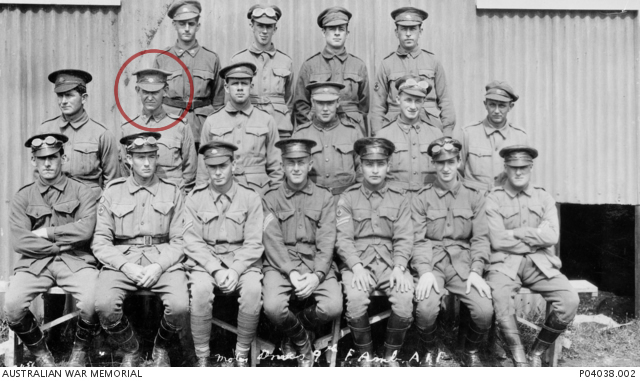 Arthur Leslie Hopper
Arthur Leslie Hopper
Elsie’s brother, Arthur Hopper is Private 11988 Arthur Leslie Hopper, a motor single driver born at Kempsey, NSW about 1894. He enlisted on 2 September, 1915 and served in the 8th and 9th Field Ambulance, 1st Motor Transport Company and the AAMC. He embarked on 2 May 1916, so he may have even been present when his sister drowned, who knows? He studied for a while at the Royal Academy of Music prior to returning home in late 1919 and passing away in 1955.
Harrington is Private 3107 Edward Richard Harrington, a single law clerk from Redfern, NSW. Where he was born about 1890.
Mr Lacey is 2nd Lieutenant John Leonard Lacey, real name Lickner. He was born at London, England on 17 October, 1886. On enlistment, he was a single commercial traveller from Nundah, QLD. He died of his shoulder wound on 9 July 1916 and is buried at Wimereux, France.
Mr Bayley is Lieutenant Keith Bayley was born either in Calcutta or in Paddington, NSW on 3 February 1891. A marine engineer, from North Sydney, NSW, he had been in the AN&MEF going to New Guinea and re-enlisted in the AIF. He went AWL twice in 1917 and was court martialled in December 1917. He returned home in March 1918, served in WWII and passed away in 1947.
R. Smith is most likely Private 1430 Reuben Smith, a single miner, born Emmaville, NSW about 1895. He is transferred to the Cyclists Corps in September 1916. He returned home and passed away at Kurri Kurri, NSW on 1 October 1945.
Bob Matthews is Private 3157 Robert Matthews, a single labourer from Leichhardt, born at Chippendale, NSW about 1883. He returned home in June 1918. His movements after the war are unknown.
Fitzgerald is Private 3763 James Augustine Fitzgerald, a single clerk from Homebush, NSW, born at nearby Concord about 1894. He rejoins the unit in late 1916 and returns home after the war.
“Nugget” Byrne is Sergeant 1511 John Byrne, an original Anzac and a Military Medal recipient for bringing in two wounded men and gathering intelligence at Thilloy on 1 March 1917. (He was recommended for a DCM) He was born in Victoria about 1890. He was the first man in the 3rd Battalion to take a prisoner in France. Unfortunately Nugget does not make it home, dying from his third wound on 14 April, 1917.
Perry is Private 4351 Clement Walter Perry, a single drilling machinist from Darlinghurst, NSW. He was born in Adelaide, SA about 1897. He returns home but not before he gets an accidental gunshot wound to the neck in 1919.
Greenhalgh is Lance Corporal 2428 Edwin “Ted” Greenhalgh, a single farmer from Singleton, NSW. He was born in Sydney on 4 March 1891. Some of his letters are at the AWM. He was a keen tennis player.
Ireland is Private 4491 James Alfred Ireland, a single clerk from Strathfield, NSW, born about 1898 at Homebush, NSW. His older brother was Horace Edward Arthur Ireland of the 19th Battalion who was returned home with shell shock in 1917, passing away in 1976.
Green is Private 3766 Michael Green, a single labourer from Surry Hills, NSW. He was born in Ireland about 1891.
Jack Pryor is Private 3189 John Herbert Pryor, being the younger of two brothers who enlisted together, is a single blacksmith from Gunnedah, NSW where he was born in 1894. He returns home after the war and passes away on 7 September, 1944 not long after he lost one of his two sons, an airman in the RAAF.
The other Pryor is Private 3182 George Saywell Pryor, a single boilermaker born about 1892, also at Gunnedah. Both brothers transfer to the Motor Transport Corps in 1917 after Jack suffers from shell shock at Pozieres and George is wounded at Moquet Farm. George returned home and lived until 1985.
Jack Simpson is most likely Corporal 1178 Stewart James Simpson an Engineer’s Assistant born in Scotland about 1890. He was a temporary Sergeant but he gets busted for being drunk and reduced back to Corporal. He is killed at Pozieres.
Episode 2.19 “And should the Madonna fall” Listen
Boniface is Private 3696 George Lawrence Boniface, a single farmer from Kiama, NSW where he was born about 1892. He will be wounded twice during the war and returns home afterwards. Of all things, George was a good marbles player! He passed away in 1974.
Broom is Private 3026 Albert Edward Broom, a married bootmaker from Redfern, NSW, where he was born about 1894. He was wounded three times during the war, returns home and dies on 7 May 1943.
Earp is Private 3752 Frederick Clarence Earp. He is a single shop assistant from Penrith, NSW, where he was born about 1893. He was killed at Bullecourt with no known grave.
Giles is Private 924 Thomas Kinnitt (or Kenneth) Giles, a single railway fettler, born at Gulgong, NSW about 1888. An original Anzac, he claims that he was the 8th man to arrive for enlistment in August 1914. He was wounded three time during the war, returns home and passes away on 28 August 1967 at Cairns, Qld.
Winder is Private 1852 Stanley Hamilton Winder, a single clerk, born at Lithgow, NSW about 1895.
Holdsworth is Charles Holdsworth, real name, Horace Lancelot Parker, born Dunedin, NZ in about 1887. He was a single miner who apparently tried to enlist earlier under his real name but was rejected.
Popoff is Private 1599 Alexander Popoff, a single seaman born at Smolensk, Russia in 1882. Another for the next episode.
Hackett is Private 500 Leslie Hudson Hackett, a single miner born at Peak Hill, NSW on 7 May 1893. An original Anzac, he returns home in May 1918, He was wounded twice but re-enlists in WWII and passes away shortly after at his hometown of Peak Hill on 15 November 1948. He was married with five young children.
Elliott is Lance Sergeant 717 Henry James Hamilton Elliott, a single school teacher, born at Tumbarumba, NSW on 28 September 1892. He was an original Anzac wounded on the day of the landing. His brother Corporal 316 John Joseph Elliott was also an original Anzac in this battalion and will be killed a couple months later.
Fergusson is Sergeant 563 Rupert Donald Fergusson, a single bank clerk born at Melbourne, Victoria on 8 January 1894. He was wounded in September 1916, returns to Australia in March 1917 and was living at Merimbula, NSW in 1955.
Bartlett is Private 3235 William Godfrey Bartlett, a single tailor from Gloucester, England, where he was born about 1888. He has no known grave.
Episode 2.20 “The Battle of Pozieres” Listen
Dunn is Private 3747 Archibald Borland Hannan Dunn, a single printer from Leichhardt, NSW, who put his age up three years to enlist. He was born on 10 August 1899 at Camperdown, NSW. He was not yet 17 when he was killed at Pozieres. His younger brother, Arthur, also tried to put his age up to enlist in 1918 but was caught.
Dunn’s father is the father of Archibald Dunn. He is Private 2082 Arthur William Dunn, a married tram driver from Leichhardt, NSW, born at Hull, England in 1873. He was wounded at Gallipoli. He may also have been Colonel Howell-Price’s batman. He was sent home in March 1918 and discharged with premature senility.
The 11th Battalion men are Privates 3705 Joseph Herbert Anderson and 4543 William Matthew Laidler. According to Private 2578 Charles Burrows of the 11th Battalion, those two and a sergeant named Ross were hit by a shell and wounded with another man while in a trench near Pozieres on 21 July 1916. The official records state that Anderson was shot in the left buttock and Laidler in the neck and suffered a fractured skull. Both were taken to the 1st/2nd South Midland Field Ambulance where they died of their wounds. They are buried in Warloy-Baillon Cemetery. Anderson was a single farmer from Dowerin, WA and was born at Kaniva, Victoria about 1891. Laidler was a single railway guard from York, WA and was born at Maryborough, Victoria about 1888. The only Sergeant Ross in that Battalion at the time does not appear to have been wounded but then Burrows’ information was second hand.
Padre Wilson is the Reverend Bicton Clemence Wilson. The longest serving chaplain to the 3rd Battalion with two stints. He was born at Cassilis NSW on 12th January, 1881 and studied at Cambridge. On enlistment, he was an Anglican minister posted at Aberdeen, NSW. He was almost as fearless as Colonel Howell-Price, even giving sermons from a second line trench parapet while under shell fire. He was loved by the men for his direct style. For example, in one sermon he said, "Some of you here today won’t be here next week. So say your prayers and stop swearing!”
Hockey is Private 3794 Thomas Hockey, a single labourer, born in England in 1889. He goes missing at Pozieres and is considered killed in action.
Steer is Private 3204 George Edward Steer, a single labourer from Newtown, born at Erskineville, NSW in 1893. His leg was badly injured and he was repatriated home in September, 1916, dying at Randwick in December 1919.

Kitchen is Private 2356 Thomas Henry Kitchen, a single labourer from Waterloo, NSW and born at nearby Surry Hills about 1892. Teddy Kitchen will be killed at Ligny Thilloy on 1 March 1917 and buried at nearby Warlencourt Cemetery.
Morgan is Lance Corporal, later Lieutenant 3165 Reginald Roy Morgan, a single bank clerk from Boorowa NSW where he was born in 1892. He will “go west” at Bullecourt.
Jagoe is Corporal 340 John Joseph Jagoe, an original Anzac and a single rail worker born at Bathurst NSW in 1894. If I had a major criticism of Lieutenant Colonel Howell-Price, it is that he seemed reluctant to put men up for decorations. If Percy’s description of this man’s actions are accurate you would think he would have got a DCM posthumously.
Hollibon is Lance Corporal 2665 Ernest Hollibon, a single chemist, born at North Sydney in 1894. He returns home after the war and dies at North Sydney on 26 June 1935, leaving a wife, Amy, and four sons.
Dave Lee is most likely Private 4512 Robert Edward Lee. This bloke was wounded in the left forearm at Pozieres, so he is my bet for the right man. He was born at Failford NSW in 1895 and was a single teamster on enlistment at the same time as his younger shop assistant brother, Private George Francis Lee. Unlike George, he does not make it home, getting killed in April 1917.
Squires is Private 4077 Samuel Squires, a married baker from Burwood, NSW, where he was born about 1886. He had two children, Harry and Edith junior.
Sergeant Wilson is 1851 Sergeant Ernest Alfred Wilson, a single ironmonger from Coonamble, born at Inverell in 1890. He did not rejoin the battalion and returned home on 29 September, 1917, dying 21 April 1945.
Wren is Captain 1487 Eric William Gregg Wren, who was an original enlistment as a Corporal in 1914. He was a single clerk from Crookwell, NSW where he was born in July 1888. He was commissioned just before Lone Pine, which he survived but suffered his second wound. He lost his right arm at Pozieres and returned home in September, 1917 with a French Croix de Guerre. He was an important man in this Battalion’s history, in fact he wrote it with some help from Corporal Len Jones. He passed away on 24 June 1941 at Melbourne shortly after taking up a posting as Deputy Director of Ordinance at army headquarters, leaving a wife and two sons, one, David a Lieutenant in the 2nd AIF. He was a keen tennis player even after he lost the arm.
Duprez is 2nd Lieutenant, later Lieutenant Arthur Otford Duprez, a single carpenter from Summer Hill, born at Bowral NSW in 1874. He was a police trooper in the Matabele War in 1896, where he was wounded saving a comrade, and also Boer War Veteran. He held the “Queen’s Scarf” amongst other decorations. He had intended to settle in South Africa and was a cattle grazier and diamond miner there for some time before returning to Australia before the Great War. He joined the 3rd Battalion just before Pozieres and was wounded three times, returning home after the war and passing away at Ben Buckler Point, Bondi, NSW on 24 October 1930. He remained single and was a public servant at the time of death.
Tommy Smith is Private 3221 Thomas Cormack Smith, a single lead light glazier, born at Blackheath NSW in 1897. He rejoins this battalion in October 1917 a few days before he gets killed
Agnew is Lieutenant, later Major, Rupert Reid Agnew. He was born on May 21, 1889. Rupe was a Tasmanian and becoame a grazier in that state after the war. He won a Military Cross at Pozieres and a bar to that in 1918. He ends the war as Brigade Major and re-enlists as a Lieutenant Colonel in WW2.
Ormiston is Private, later Lieutenant 3108A Irving William Leonard Ormiston, a single wheat farmer from Cowra, born at Bathurst NSW on 19 June 1895. After returning home, he lives at Gunnedah, but dies in London in 1969. He may have called himself by his third name, “Leonard.” He played for NSW against the All Blacks on 24 July 1920. Unfortunately the All Blacks won 26:15.
Graham is probably Private 2148 William George Graham, a single butcher from Artarmon, NSW. He was born in 1898 and put his age up to enlist with his older brother, Nichol Graham. He is killed at Bullecourt.
Paddy Kelly is Private 1980 Patrick Fanahan Kelly, a single baker from beautiful Gerringong, NSW where he was born about 1889. He was mistakenly reported as killed at Lone Pine but really was wounded at Moquet Farm and sent home in late 1917. Paddy passed away at Burwood, NSW in 1959.
Middleton is Captain Roy Oswald Middleton, an architect from Vaucluse, born at Bathurst NSW on 1 June 1891.
Donovan is Private 4023 Richard Joseph Donovan, a married grocer from Redfern NSW in 1873. He was killed at Moquet Farm in August 1916.
Brain is Private 580 Percy Sidney Raymond Brain, a single blacksmith born at Menangle NSW in 1894.
Wiseman is Private 2971 Victor Mervyn Wiseman, a single grazier, born at Gundy NSW in 1895. Killed at Ypres in 1917.
Leary enlisted as Private, later Corporal 3126 George Thomas Leary. His name is possibly Simon P Leary, born at Delegate NSW in 1898, or his birth was not registered in 1897. He will be wounded at Bullecourt and return home after the war. One interesting fact is he is accused of stealing a watch from a dead mate (Private Wadhurst) by the guy’s father.
Buckley is Private 1098 William Thomas Buckley. He was born in Lancashire, England in 1887 and was an excellent singer. He was wounded three times in the war.
C McK is Private 3340 Charles McKnight A single farmer from Bellingen, NSW, he was born at Burwood, about 1886. He has no known grave.
Episode 2.22 “Snipers at Moquet Farm” Listen
Mapstone is Private 2652 George Alfred Mapstone, a single carter from Banksia, born on 6 October, 1894 at nearby Rockdale, NSW. He was sent home in January 1917 and passed away on 23 July 1952, while living at North Bondi. George had a keen interest in rugby league, swimming and lawn bowls.
Philpot is Private, later Lance Corporal 2770 Ernest Alfred Philpot, a single labourer from Tarago, NSW, born at South Hackney, London, England in 1886. He was not killed this time but gets wounded in September 1918, returning home after the war and dying at Bathurst NSW in 1942.
Alby Watson is Private, later Lance Corporal, 3242 Albert William Watson, a single fitter from Croydon Park, born at Glebe NSW in 1892. He will be wounded twice and sent home in July 1917.
Blake is Lieutenant, later Captain, 553 Giles Eyre Blake, an original 6th Light Horse enlistment and Anzac. Before the war he was a single station overseer, born at Killara, NSW about 1889. This man had been wounded at Gallipoli but sees the war out and passes away in 1952. He was mentioned in despatches in late 1918.
White is Private 3496 Rupert White, a single grocer from Jerilderie, NSW, where he was born on 27 July 1895. Rupe returns home with a Military Medal with the following citation; "For conspicuous gallantry and devotion to duty during the attack near Dernancourt Ridge South West of Albert on 5th April, 1918. When his Officer was killed and all other N.C.O.'s were out of action he took charge of the platoon, rallied the men and led them to the attack. Although wounded in the shoulder he carried on and consolidated his platoon position. At nightfall he, in company with L/Corporal Ritchie went forward and located the position of the enemy so successfully and brought back such information as enabled his Company Commander to make his defensive position secure where it might have been dangerously weak." He re-enlisted for home defence in WW2 and passed away at Boxhill, Victoria in 1969. His wife Doris predeceased him and they had four children.
Callaghan is Private, later Sergeant 1716 Alfred Callaghan and was born in Sydney in 1891. Also known as ‘Mad’ Callaghan, he was a single sawyer from Bankstown on enlistment.
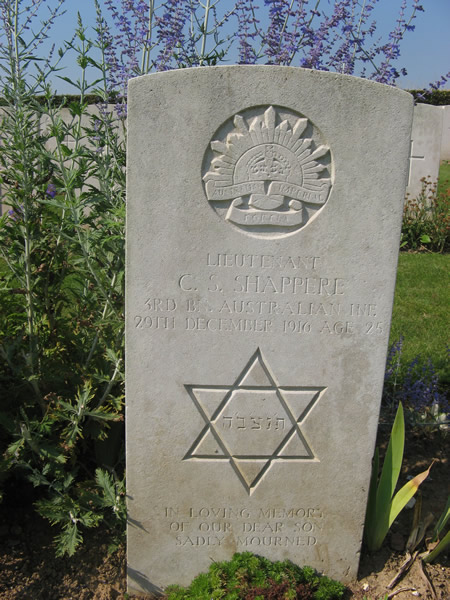
Mr Shappere is 2nd Lieutenant, later Lieutenant Cyril Solomon Shappere, a single merchant from Blayney NSW, born at Paddington in 1892. He was very popular and the life of any party. He was killed on 28 December 1916 during heavy shelling at Flers/Guedecourt.
Barber is Warrant Officer 90, Albert Edward Barber of the 1st Battalion, a married bookseller from Lidcombe NSW, born about 1883. He returned to Australia in March 1918 and passed away on 19 March 1942.
Joe Hendy is Private 3103 Henry George Hendy, a single carter from Gloucestershire, England where he was born on 19 March, 1894. He may have been living at Chatswood, NSW when he enlisted. Joe was wounded at Flers in 1916 and Bullecourt, sent home in late 1917, dying at Lane Cove, NSW in 1962.
Yorky is Sergeant 195 John Yorke, a labourer on enlistment. He was wounded a total of five times and was awarded a Military Medal.
Murray is Lance Corporal 1145 Stanley Walter Murray, a single farmer, born at Tumut, NSW about 1894. He was wounded earlier at Gallipoli.
Wackett is Private 2932 Charles William Wackett, a single labourer born at Plumstead in Kent, England about 1893. He rejoins the battalion and is wounded again in June 1918, being sent home a couple days before armistice. He died on 15 July 1958 at Auburn, NSW.
Les Warner is Private, later Lieutenant 584 Leslie William Roy Warner of the 34th Battalion, a single jewellery salesman from Annandale, NSW, born at Sydney about 1895. He will die of wounds at Messines, Belgium on 8 June, 1917. He was battalion scout officer.
Wotton is Private 2836 William Allan Wotton, a single miner from West Wallsend, born at Homebush, NSW about 1889. He returned home after the war and died at West Wallsend in 1961.
Blumer is 2nd Lieutenant 1488 Colin Charles Blumer, an agricultural student from Grafton, NSW who was born at Mudgee on 25 November 1896. An original Anzac who put his age up to enlist. He was recommended for a Distinguished Conduct Medal at Pozieres, but was awarded the Military Medal. He was also Mentioned in Despatches in October 1916 at Ypres. Although he lost an eye and returned home in May 1917, he re-enlisted in WW2 as a Major and a veterinary surgeon. Blumer was chairman of the Tick Control Board after WW2 and died on 2 July 1973.
Doctor Fitzpatrick is Captain Samuel Charles Fitzpatrick. He was born on at Heyfield North in Victoria on 20 November, 1892 and was a graduate of Melbourne University.
Bill Graham is Lieutenant 2144 William Graham, a single clerk from Brunswick, Victoria. He was born at St Helens, Lancashire, England about 1894. This Military Cross winner was wounded at least twice during the war and returned home a couple days before the war ended. He won the MC at Warneton on March 13, 1918, for reconnaissance work retrieving papers from dead Germans in full view of the enemy. He died on 4 January 1955.
Episode 2.23 “Hill 60 or Hell 60” Listen
Waterhouse is Private 3261 Charles Waterhouse, a married builder from Moore Park, NSW, born at Geelong VIC about 1877. He is killed at Flers.
Mr Pestell is Lieutenant 1303 Joseph Victor Pestell. He was born in 1893 at Lismore, NSW.
Cox is most likely Private 3736 William George Cox, a single labourer from Milparinka NSW, born at Broken Hill about 1895. He returns to Australia.
Barron is Sergeant 2566 Harley James Baron, a single farmer from Leeton or possibly Drummoyne, NSW where he was born about 1894.
Fenton is one of three men, two being brothers and the third is the son of one of them. It is not certain which of the three Percy is referring to. All three were recently taken on strength to the Battalion together, only a few weeks earlier.
Love is Corporal (temporary Sergeant) 466 Dallas Fairbairn Love, a single dairy expert, from Port Macquarie, born at Kogarah, NSW about 1892. He studied at the Hawkesbury Agricultural College before the war and was known to have been a good athlete.
Bill ‘Hoojah’ Elliott is Lieutenant 5074 William Frederick Elliott. He was born in Ireland on 9 September, 1879 and his father was a professor at Trinity College in Dublin. He was a married farmer on enlistment.
Whitby is Private 6398 George Edward Whitby, a single farm hand from Drummoyne, born at Glebe Point about 1897. He returns home in May 1917.
Les Tanner is Leslie Frederick Tanner, born at Sydney on 28 September 1887, the fourth and youngest child of Edward and Matilda Tanner. His service number is 310040, but as yet I don’t know which ship he served on, what his rank was or if he actually did fight at the Battle of Jutland. Courtesy of Keith Hollick, of the Battle of Jutland facebook group, he is known to have enlisted in the Royal Marines on 21 April 1906, transferred to the Royal Navy shortly after but then inexplicably deserted on 3 July 1910. It is possible that he re-enlisted under a false name, but we can’t be sure. Les returned to Australia after the war and passed away at Bulli, NSW in the early hours of 13 May, 1934. At that stage, Les and his mate, John Joseph Finlay, were chimney sweeps who were camping in an unoccupied cottage in the local park. Both men had been drinking heavily the night before and his death was not considered to be suspicious. He is buried at Woronora Cemetery (Pbn W 0029) in a family grave with nothing to indicate that he was a sailor of the great war.
Charlie Bodsworth is Sapper, later Sergent 9177 Charles William Thomas Bodsworth, a single clerk from Marrickville, NSW, born at South Brighton, VIC about 1889. Later in 3rd Division Signal Company, he returns to Australia in1919.
Preston is Corporal later 2nd Lieutenant and later still Wing Commander 2774 Walter George Preston, a single clerk from Balmain, born at Toowong QLD in about 1893. He is discharged from the AIF to join the Royal Flying Corps in March 1917 and is posted to 210 or 101 Squadron. He flew FE 2d’s, BE12’s Avro 504J’s and A154 Nieuport 20’s, apparently. Walter returned home after the war with a Distinguished Flying Cross won for night bombing sorties.
Bowling is Private 3348 Roy Bowling, a single labourer from Wongarbon, NSW, born at Ramornie about 1896. He returned home after the war and passed away in 1975.
McBride is Private 3284 Patrick Raymond McBride, a single dairy farmer from Raymond Terrace, NSW, born in Sydney on 19 May, 1891. He was wounded at Passchendaele and sent home in early 1918.
Episode 2.24 “Piano Man ” Listen
Roy McPhee is Corporal, presumably acting Sergeant, and later Lieutenant 2249 George Roy McPhee, a single civil servant from Ryde, NSW, born at harbourside Double Bay in late 1889. Despite being wounded and gassed, he returns home after the war and passes away at Marrickville in 1964.
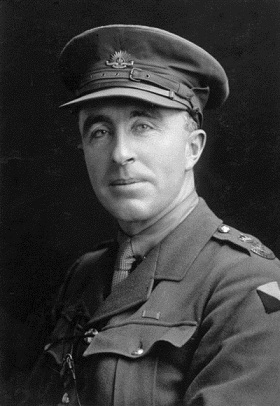
The first “Colonel” is Major, with temporary rank of Lieutenant-Colonel, Richard Francis Fitzgerald who was in command of the Battalion from 23 September 1916 until the return of Colonel Watson. He was a married career soldier from Milson’s Point, NSW, born on 23 April 1880. He was later in the 51st, 52nd Battalions and the Australian Cyclist Corps. He was awarded a DSO and was mentioned in despatches. He returned home after the war.
McIlroy is 571 Captain George Stanley McIlroy, a married optician from Melbourne, born at St Arnaud, Victoria about 1890. He won the Military Cross. He was sent home with Neurasthenia in March 1917. He was living at Ivanhoe, Victoria in 1946 and died on 24 October 1953.
Hartley is Private, later Lance Corporal, 4432 James Hartley, a single fireman from Wonthaggi Victoria. He was born in 1890 at Homebush Victoria and returned home in November 1917 after being wounded in May.
Hunter is Lance Corporal, later Regimental Quartermaster Sergeant (W.O. Class II), 1577 Lionel George Hunter, a single clerk from St Kilda, Victoria, born at Kensington Victoria about 1894. He returns home in 1919.
Sergeant Henry is Corporal 208 Arthur Milton Henry, a single butcher from North Geelong Victoria. He was born at Corio Vic in 1893. He died at Passchendaele and he has no known grave.
Mr Pittard is Lieutenant Edward James Pittard, a single clerk from Burnley, Victoria born on 3 October 1888. He won a Military Cross at Bullecourt on 12 May 1917 for conspicuous gallantry during an assault on enemy trenches when he continued to lead his men despite a severe wound to the right leg, until he collapsed. His unit achieved their objective. He did not return to active service and returned to Australia in early 1918.
Jim Dawson is almost certainly Private later Lance corporal 4657 James Robb Dawson of the 13th and later 1st battalions, a single labourer from Epping, NSW, born in Wollongong in early 1894. He was wounded on the 30th August 1916. He was charged with desertion in September 1918 and convicted. He returns home after the war and passes away in 1977.
Watson is Lieutenant-Colonel William Walker Russell Watson, a Boer War veteran born on 19 May 1875 at Balmain, NSW. A dentist on enlistment, he had been commissioned as a Lieutenant in the NSW Scottish Rifles and 4th Infantry Regiment in 1896 and finishing the war as a Captain. Amongst other things, he commanded the NSW detachment of the Coronation Corps at King George V’s coronation in 1912. He commanded the Infantry component of the AN&MEF in September 1914 and took part in the capture of Rabaul. Later he took command of the 24th just before Gallipoli and later in the war the 2nd Division Training School. He was wounded on 7 August 1916 and returned to the Battalion on 13 October 1916. He returned home in 1919 and died in Sydney of septicaemia resulting from influenza on 30 June 1924. He reportedly caught the ‘flu at another officer’s funeral. He was known to be a tough leader but well respected by his men.
Episode 2.25 “About Fromelles and Devil’s Wood” Listen
Campbell is Lance Corporal 127 Duncan Campbell, a single farmer from Inverness, Scotland, where he was born about 1893. Initially enlisted as a Sergeant, he reverted to private in June 1915, no reason given. He suffered shell shock twice during the war, returns to Australia in 1919 and moves to New Zealand for a period but was living at Main Ridge, Victoria in 1967.
Gordon is most likely Private 770 Samuel Garner Gordon, a single groom from Ballarat, where he was born about 1896. Sam was wounded three times during the war. He returned home after the war.
Dick Weales is Private 2227 Richard Arthur Weales, a single confectioner from Brunswick, Victoria and born about 1890 at London, England. He received a head wound at Passchendaele and got sent home in early 1918.
Snadden is Corporal 270 Walter Snadden, a single engineer from Footscray, Victoria where he was born about 1880. He was wounded on 26 February 1917 and died of his wounds two weeks later. He is buried at St Sever Cemetery, Rouen, France. He had two brothers, James and Harold, also in the AIF. The family were well known around Footscray.
Wally Smyth is Private 283 Walter Samuel Smyth, a single horticulturist from Nathalia Victoria, where he was born about 1894. He was a serial deserter, for three long periods in 1917 and 1918. He was sentenced to 21 days FP No.2 the first time and 2 years hard labour the second. He had been wounded twice, including at Moquet Farm, although by then he had already been AWL for a couple days. It appears he was killed in a motor vehicle accident about 1942.
Jack Cooley is Private 2233 John Cooley, a single seaman from South Melbourne, born Zeehan, Tasmania about 1893. He returned home in early 1918 after he was wounded in the stomach at Passchendaele. He died on 6 May 1967. He was married to Dorothy and had been living at Heidelberg, Vic.
Laidlaw is Private, later Sergeant 222 Robert Laidlaw, a single carpenter from Newcastle NSW but born at Corowa about 1893. He was wounded once only, at Gallipoli, and returns home with a Belgian Croix de Guerre. He dies sometime before 1967, leaving a wife, Florence. His Croix de Guerre was for several incidents between March and October 1918.
Morcom is Company Sergeant Major 1733 Edmund John Morcom, a single draper from Bendigo Victoria, born at Sandhurst Victoria in 1893. He was wounded three times, and he also served in WW2. He passed away sometime before 1967, leaving a wife, Constance, who appears to have been his second wife, he having married an English girl named Doris Noble before he came home in 1919.
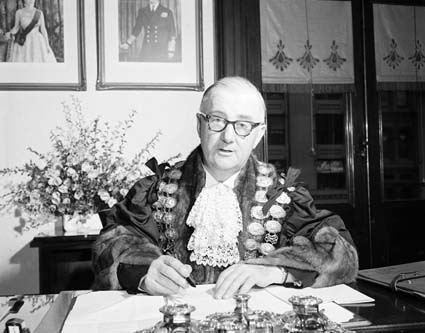
Mr Selleck is 121 Francis Palmer Selleck, a single clerk from Numurkah, Victoria where he was born on 20 August 1895. He enlisted as a Quartermaster Sergeant and ended the war as a Captain. He was Battalion Adjutant and won his MC for scouting work in 1918. After the war, he became an accountant and business man and a significant figure in both Legacy and the forerunner to the RSL. Sir Frank Selleck KBE was the Lord Mayor of Melbourne from 1954, through the Olympic Games in 1956 and he passed away on 2 October 1976 at Armadale, Victoria.
Burns is Lance Corporal 1120/2030 John Rogers Burns, a single storeman from Waratah Bay, Victoria, born South Melbourne about 1893. An original enlistment in 1914, he was sent overseas twice, first returned in April 1915 due to having a venereal disease, presumably treated and sent back in time to serve at Gallipoli from late October 1915. Corporal JM Collery sent the following note to his parents, “I feel as I should write you a few lines concerning the death of your son, Corporal J.R. Burns, at Bullecourt on the 3rd May last. He was in the same platoon as myself and was very well liked by all the boys, there was every prospect of him getting a commission should he survived that stunt.” He has no known grave.
Canterbury is Private 164 Charles William Canterbury, single driver from Bendigo, Victoria, where he was born about 1894. He was wounded at Moquet Farm and again in 1917. He was promoted to Lance Corporal but lost his stripe after going AWL for 9 days at the end of 1917. He returned home with an English bride, Beatrice Benham. He dies on 17 April 1983, so a good innings for a man wounded twice in the Great War.
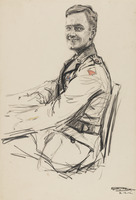
Nicholas is Major George Matson Nicholas DSO, which he won at Pozieres with the following citation, “For conspicuous gallantry and initiative. having whilst on reconnaissance discovered a machine gun, Captain Nicholas went out again alone, and with great dash and initiative captured the gun”. He also had been personally acknowledged in a letter from General Birdwood. He was a single high school teacher and law student from Trafalgar, Victoria, born Coleraine on 3 March 1887. He enlisted a couple days after the Gallipoli landings. “Matson” as he was known, was the oldest of six brothers. He was wounded at Gallipoli. His brother Lieutenant Byron Fitzgerald Nicholas was also in the 24th and was killed at Passchendaele. Major Nicholas is buried in the Grass Lane Cemetery near Flers. The AWM holds a drawing of him by his new wife, Hilda “Rix” Nicholas, whom he married in England shortly before he was killed.
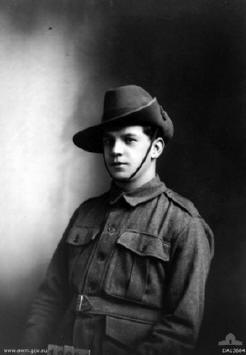
Leoshkevitch is Private 3857 Faust Leoshkevitch, a single railway worker from Melbourne, born Kovno, Russia, now Grodno, Poland on 18 November 1896. His mother was living at Askhabad or Ashgabat, now in Turkmenistan during the war. Faust arrived in Australia with four other young blokes working as crew on the Gunda on 3 January 1915. He returned to Australia after being gassed twice. His father was a Colonel in the Imperial Guard and his brother an officer in the Russian army. He apparently had a great sense of humour, if asked whether he was a red Russian or a white Russian he would reply that he was a pink Russian. If called Ivan he would say “Yes, Ivan the Terrible”. Faust passed away on 26 August 1967, leaving a wife, Pauline and son Leon.
Radley is Private, later Sergeant, 262 John Joseph Radley, a single labourer from South Melbourne where he was born in 1891. He won a MM at Broodseinde Ridge on 9 October 1917 where he organised a flanking manoeuvre around an enemy post. The Germans weren’t impressed though, they shot him in the butt and he was evacuated. He returns home and passes away on 10 September 1969.
Mundell is Sergeant 1734 Arthur Mundell, a single marine engineer, born Newcastle England about 1885. He is buried at Beaulencourt Cemetery at Ligny Thilloy. He won his MM at Moquet Farm for holding a post during heavy shelling and counter attacks for nearly 2 days from 25 to 27 August 1916.
Cumming is Private, later Sergeant 2232 John Cumming, a single grain buyer from Katunga, Victoria, and was born at Inglewood about 1890. He was wounded three times before being killed at Mont St Quentin on 2 September 1918 and buried at Peronne.
Reg Gibbons is Lieutenant Reginald Leslie Alfred Gibbons of the 5th Field Artillery Brigade, a single auctioneer and stock agent from Ascot Vale Vic, where he was born about 1889. He returned home after the war.
Alec Cameron is most likely Private 2804 Alexander Murdoch Cameron, a single stock and station agent, born at Albury NSW about 1892. Of the 5th Battalion, he was killed at Pozieres and has no known grave.
Jack Wilson is probably Private, later Sergeant 885 John Wilson of the 1st Battalion, a single bootmaker from Corowa NSW, where he was born in 1891. He returned home after the war.
Ernie White is Lieutenant Ernest Victor White, a single butcher from Dromana Victoria where he was born on 22 March 1894. His parents are Robert and Mary Hannah White (nee Roberts), these two having married in 1886. This Anzac enlisted in May 1915, arrived Gallipoli in late August that year and was later wounded at Bullecourt and Montbrehain. He won the DCM at Ville-sur-Ancre on 19 May 1918:
"For conspicuous gallantry and devotion to duty. During an attack this N.C.O. who was in charge of the advance party of his platoon, led them with great gallantry against a machine gun post, which he captured, taking the gun, and accounting for all the gunners. He then collected his party and proceeded, with the greatest dash, to occupy the objective which had been assigned to them. He brought up a Lewis gun, which he disposed with much judgment to help in overcoming the last elements of the enemy's resistance, and then went out under heavy rifle fire to help in selecting positions for the outposts. Throughout the day he showed fine qualities of judgment and cool determination, which inspired his men with great confidence."
He returned to Australia and married Hazel Irene. He died on 5 October 1953 at Albury, NSW.
Episode 2.26 “Plastered in mud” Listen
Bird is Lance Corporal 102 Fred Bird, a woodworker from Mentone, Victoria, born at Reading, Berkshire, England born in January 1897 and died 19 November. Fred arrived in Melbourne age 16 years with his mother, Kate, and at least one sister, Ivy. He was young to get a stripe in September 1916.
Burrows is Private 4077 Frederick Thomas Burrows, a single presser from Kensington Victoria. He was born at Northcote, about 1897. He returns home in January 1919 and was still alive in 1964. A Frederick Thomas Burrows was fined in 1935 for not keeping his property free of weeds!
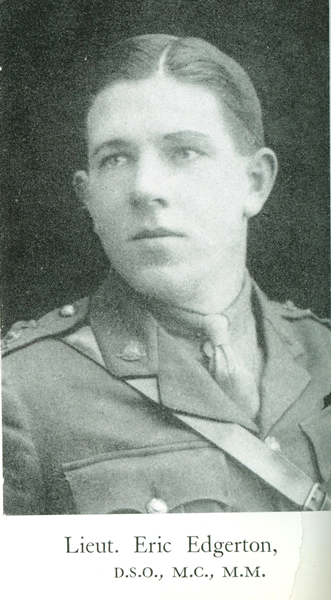
Edgerton is Sergeant, later lieutenant 1524 Eric Henry Drummond Edgerton MM + Bar and DSO, a single student on enlistment. He was born at Moonee Ponds, Victoria on 1 April, 1897. The MMs were won at Owen’s Gully Gallipoli in 1915 and at “Dinkum Spur” near Warlencourt on 26 February 1917, he was recommended for a VC in May 1918, receiving instead the DSO and a mention in despatches. He enlisted just after his 18th birthday and was commissioned at 20. Edgerton was killed in battle as recounted by a fellow officer. 'This Officer met his death during the advance of his Battalion near Raincourt on August 12 1918. He was in charge of a platoon and had just left his trench in order to visit one of his forward posts when he was struck by a bullet from an enemy machine gun which was active some distance in front. The bullet pierced his heart and he died immediately.' Raincourt is near Villers Bretonneux and he is buried at the VB Cemetery.
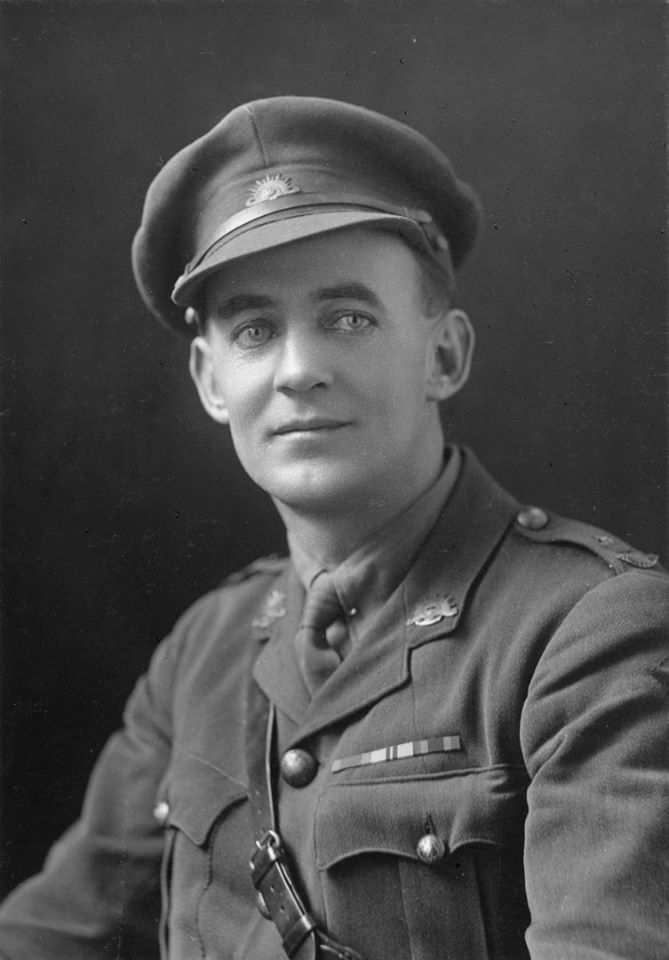
Trew is Major William Merriman Trew, a married grazier from Mansfield, Victoria. This Boer War veteran was born at Stawell on 26 January 1880. He enlisted in February 1915 as a 2nd Lieutenant and rose to Major in November 1916. He was wounded in the hand and forearm in May 1917. It appears the wound never properly healed and he was sent home to Australia in March 1918. Major Trew was awarded the DSO and was mentioned in despatches. He died on 22 July 1934, leaving a wife, Constance.
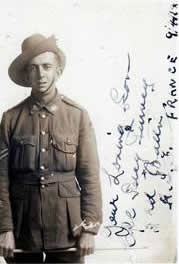
“Topsy” Turvey is Corporal 2693 Percival Turvey, DCM and MM, a single labourer from Rhylstone, NSW, who was born on 23 March 1892 at Wagga Wagga, NSW. He returned home after the war, served again in WW2 and died at Gosford, NSW in 1965. His DCM was awarded for an action at Mont de Merris on April 14, 1918. Rather than read the citation, this is how it happened in Topsy’s own words as reported in Reveille and the 3rd Battalion history by Captain Wren;
“Reaching a position about 300 metres in the rear of “Gutzer” Farm, I was required to take out my company Lewis guns and act as a covering party, while new trenches were dug. The night was slipping away fast, and we knew Fritz would attack at dawn. While scouting for gun positions in the semi-darkness, I discovered the bodies of a young woman about 25 and a girl of 8. Evidently, they had been caught by enemy gun-fire during the day. At the sight of those poor souls, I saw ‘red’ and swore to take toll of Fritz if an opportunity came. Digging operations completed just before daybreak, my guns were withdrawn to the front line. But the position at “Gutzer” Farm appealed to me as an observation post, and I received permission from Lieutenant “Dad” Jarvis to take a Lewis gun out there. Four men readily volunteered to go with me and carry ammunition. We had scarcely got into position and were gazing towards the village of Merris, over the undulating country, when we saw miles of infantry, slowly, but surely, goose-stepping towards us. Officers on grey horses were riding up and down the column. It really was a wonderful sight. I sent one of my men back to headquarters with a message, and within a few minutes the most wonderful slaughter was going on. However, in spite of terrible losses, Fritz kept coming on, and was soon within point-blank range of my gun. So I decided to present him with 1,150 rounds of SAA. It was like firing into a haystack – one could not miss. The Germans were about six deep in places. They were very much unsettled in front, but kept creeping up on both flanks. I sent the other three men back to the line while I emptied the remaining magazines. As I finished, there were “Hocks” uncomfortably close, so I grabbed the gun and bolted across No-Man’s Land, followed by a hail of bullets. I reached the trench without a scratch, though one bullet tore a hole in the back of my tunic.”
Mr Bishop is Lieutenant 197 Harold Mackay Bishop. He was born at Moruya, NSW in 1893 and was coachsmith on enlistment.
McMaster is Sergeant, later Lieutenant 4530 Allan Stewart McMaster, a single bootmaker from Newcastle, born at Inverell NSW about 1895. He was killed at Hermies.
MacDougall is CSM, later Lieutenant 3094 George Ross MacDougall, a bank clerk on enlistment and born at Bathurst NSW about 1884. “Ross” would be wounded twice during 1917, return home after the war and pass away on 22 January 1930. He was a good footballer.
Episode 2.27 “Murdered in cold blood” Listen
Tom Avery is Private 3004 Thomas Avery, a single liquor trader from Surry Hills, NSW, who was bornabout 1881 at nearby Pyrmont, his parents being Thomas and Mary Avery. During the Spring Offensive in 1918, the Germans pushed the British front back to the vicinity of Villers Bretoneux. A young refugee woman from Baillieul was separated from her family. While her father and brother tried to find her mother in hospital, she was asked to wait at a crossroad. The German advance guard cut her off from her family and she had to hide, watching the town and possibly her family being heavily shelled. The men of the 3rd Battalion found her in late April and the men provided her with money and food. Tom Avery took her to the refugee camp in the officer’s mess cart. (Wren P292).
Tom was in the 7th Reinforcement of the 18th Battalion and like many of the men in that group he was taken on strength to the 3rd Battalion instead of the 18th Battalion. Tom was wounded at Moquet Farm, so he was not in the Battalion when Jimmy Voss was killed. Tom returned to Australia in 1919.
Horatio Nelson is Private, 1668 Horatio John Nelson, a single clerk from Auburn, NSW, born at Redfern in 1887. He was wounded three times during the war and returned home afterwards, passing away on 19 September 1937 at Royal North Shore Hospital. He was a long time resident of Auburn, were his father had conducted a ham and beef store.
Ernie and Alf Graham are Percy’s first cousins, their mother Clara being the sister of Percy’s dad. The older boy Private 3560 Ernest William Graham was born at Derby Tasmania, where he still lived, in about 1891. Private, later Driver, 3561 Alfred Edward Graham was about six years younger, born in 1897. The boys were in the 12th then 51st Battalions until the final stages of the war when they transferred to the 49th. Alf was wounded once in April 1918. Both boys were single farm labourers when they enlisted together in August 1915 and returned home after the war, Ernie passing away on 13 May 1972 and Alfie on 7 April 1974. At the time of their mum’s death in 1943, Alf was living in Queensland while Ernie was still living somewhere in Tasmania.
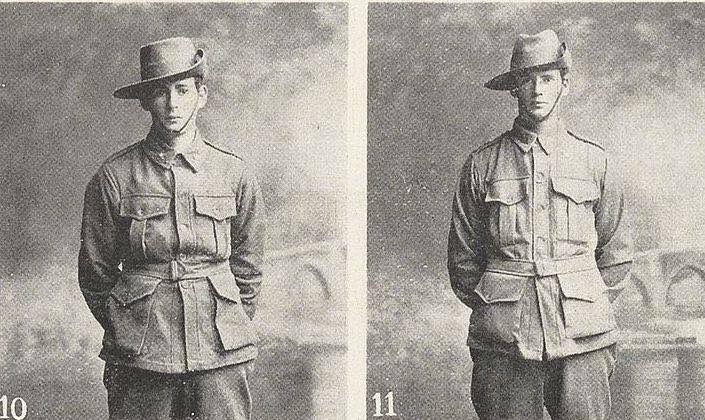
Ernie Glover is Wireless Telegraphist Operator WTS204 Ernest Henry Glover of the Royal Navy Reserve. He was born at Sparkbrook, Birmingham on 29 September, 1882. He was invalided from HMS Peel Castle suffering from tuberculosis. He succumbed to his illness on 18 April 1917.

Corporal McAdam is Corporal 3876 John Lachland Noble McAdam, a single clerk from Brunswick, Victoria, born at Castlemaine about July 1889. He was sick a couple of times during the war, including having “trench fever” but was not wounded and returned home after the war.
Jack Thorpe is possibly 2817 John Thorpe, a single labourer from Brighton le Sands, NSW.
Captain Ellwood is Captain, later Major, William Henry Ellwood, a married school teacher from South Gippsland, Victoria, born in Wunghnu, Victoria on 19 April 1889. He received the Military Cross for staying on duty at Bullecourt after leading his company in a charge and then securing the brigade’s flank against German counter-attacks. Wounded at Bullecourt, he recovered and returned home after the war. He went back to teaching while studying for his BA, Master of Education and MA. In 1937 he was appointed Assistant Chief Inspector of Primary Schools and in 1951 he was the Chairman of the Victorian Teacher's Tribunal. He was awarded the Queen’s Coronation Medal in 1953 and was alive and well, living in Glen Iris, Victoria in June 1967.
Episode 2.28 “English and French” Listen
Roser is most likely Private 4507, Reginald Ernest Roser of the 2nd Machine Gun Battalion, a single labourer from Tamworth, NSW, where he was born about 1893. He was at Perham Downs at the same time as Percy. He returns home after the war.
General Murray probably refers to General Archibald Murray, formerly Chief of the Imperial General Staff and, at this stage the commander of the Egyptian Expeditionary Force. Although the date that Percy says this inspection happened is about 2 weeks before the First Battle of Gaza so it's not certain why he would have been in England.
Doctor Hagen is Captain, later Major, Harry Alexander Hagen, real name, Henry Alexander Hagenauer, a widowed medical practitioner from Adelaide, SA, born at Traralgon, Victoria on 7 November 1878. He returned to Australia in November 1918. He suffered badly from arthritis throughout the war only doing one stint in France over the winter of 1916/17.
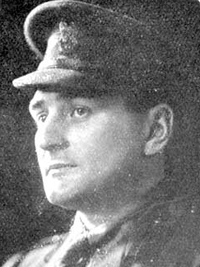
Colonel Knox is Lieutenant Colonel George Hodges Knox, a married farmer from Melbourne, born at Armadale, Victoria on 17th December 1885. Previously CO of the 23rd Battalion, by this stage, 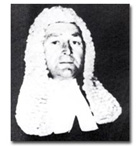 he was commandant at the Base Depot there at Perham Downs. He was sent from the front due to recurring bronchitis and asthma and eventually repatriated home in June 1918. He re-enlisted in WW2, with the rank of Brigadier. Sir George Knox, Victorian Parliamentarian from 1927 until 1960, was the speaker of the house in the 1940s, was living at Ferntree Gully, Victoria and died on 24 October 1960.
he was commandant at the Base Depot there at Perham Downs. He was sent from the front due to recurring bronchitis and asthma and eventually repatriated home in June 1918. He re-enlisted in WW2, with the rank of Brigadier. Sir George Knox, Victorian Parliamentarian from 1927 until 1960, was the speaker of the house in the 1940s, was living at Ferntree Gully, Victoria and died on 24 October 1960.
Lance Corporal Harrison is Lance Corporal 4592 Herbert William Harrison, a single clerk from Williamstown Victoria. He was born at Hawksburn, Victoria about 1896. Harrison was killed on 25 February 1917 at Warlencourt and has no known grave.
Corporal Bruce is Corporal 806/1011 John Ernest Alexander Bruce, a carpenter and an original enlistment to the AN&MEF in August 1914. He was born at Wagga Wagga, NSW about 1886.
Corporal Ellis is almost certainly Corporal 1353 Leo Anthony Ellis of the 3rd Battalion. He was a single sheet metal worker, born at Leichhardt, NSW in 1893. He was wounded at Pozieres and did not rejoin his unit until after Passchendaele. He returned home after the war, was living at Ingleburn, NSW in 1967 and passed away in 1971.
Sergeant Carroll is Sergeant, later RQMS 2389 Gerald Carroll of the 3rd Battalion. He was a married labourer on enlistment, born in NZ about 1883. He returns home after the war and passes away on 3 August 1956 at Port Macquarie, NSW.
Stan Martin is most likely Private 3376 Samuel Stanley Martin of the 3rd Battalion. He was a single locomotive fireman born at Newcastle, NSW about 1892. He was previuosly in the AN&MEF and took part in the capture of New Guinea from the Germans in September 1914. He was wounded at Moquet Farm and finished the war in the Pay Corps before returning home.
Pennell is most likely 1454 William Edwin Pennell, MM and Bar and DCM winner. He enlisted as a single hairdresser and was born in 1887.
Captain Abbott is most likely Captain Adrian Augustus Abbott of the 20th Battalion who appears to have been at Perham Downs around this time. This graduate of Royal Military College Sandhurst, was born on 29 January 1886 and was a married military officer and school master on enlistment. He was living in Karachi, Pakistan in 1922 and serving in the Indian Army.
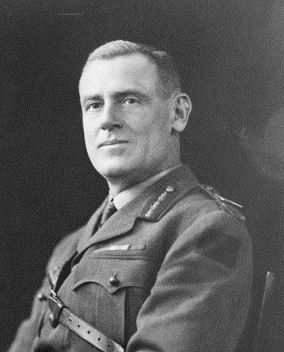
Brigadier Antill is Brigadier General John Macquarie Antill, a professional soldier from Picton NSW where he was born on 26 January 1866. He enlisted at the outbreak of war in the 3rd Light Horse Brigade. He had been a captain then Major in the NSW Mounted Rifles in the Boer War where he was involved in the relief of Kimberley and several other engagements. He was Brigade Major in 1915. He later commanded the 16th Infantry Brigade, before returning home in late 1917. He passed away on 1 March 1937.
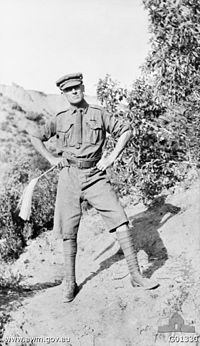 Antill is depicted in the 1981 film Gallipoli by Peter Weir. During the Battle of the Nek, on 7 August 1915, between 4.30 and 4.45am three successive waves of lighthorsemen were mown down during the attack on heavily fortified trenches which had been badly bombarded. The CO of the fourth wave, Lieutenant Colonel Brazier tried to have that wave cancelled but Brigadier Hughes and Major Antill failed to do so before many of the men went over the top. In fact, most accounts have Antill insisting that the attack continues. He was knighted after the war.
Antill is depicted in the 1981 film Gallipoli by Peter Weir. During the Battle of the Nek, on 7 August 1915, between 4.30 and 4.45am three successive waves of lighthorsemen were mown down during the attack on heavily fortified trenches which had been badly bombarded. The CO of the fourth wave, Lieutenant Colonel Brazier tried to have that wave cancelled but Brigadier Hughes and Major Antill failed to do so before many of the men went over the top. In fact, most accounts have Antill insisting that the attack continues. He was knighted after the war.
Sivell is Private 2911 Ernest Thornton Sivell of the 13th Battalion, a single painter from Young, NSW where he was born about 1884. His is wounded 3 times, and goes AWL a few times. He gets sent home in June 1918 and passes away at Newtown, NSW in 1970.
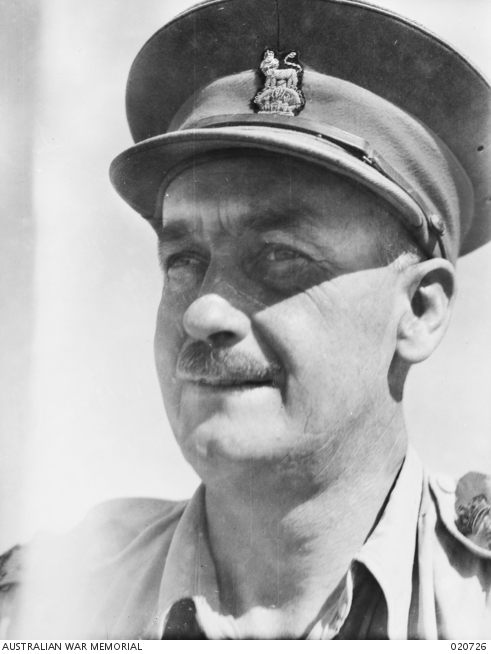
Captain Godfrey is Captain, later in WW2 Brigadier 1953 Arthur Harry Langham Godfrey, MC DSO + Bar. He was an auctioneer, born 26 January 1896 at Newtown, Victoria. He was gassed in 1918, returned home, held various roles between the war, re-enlisted as a Lieutenant Colonel in 1939 and died of wounds received from shelling at Egypt on 4 November 1942.
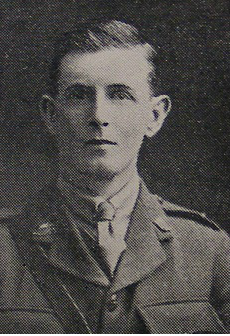
Bill Gow is Lieutenant 983 William Burns Gow, a single school teacher from Harrietville, Victoria where he was born on 28 May 1893. He was recommended for a Military Cross in 1917 which he did not get but he did win one at Mont St Quentin. He was wounded by MG fire shortly after. He returned to Australia in 1919 with his English wife, Violet Wood, whom he married in March 1918. He was living at Belmont, Victoria in 1967 and passed away at Geelong on 31 December 1978.
Joe Scales is private later Lieutenant 1738 Joseph Lindley Scales, a single contractor from Mitta Mitta, Victoria, born August 1885. He won a MM in March 1917 at Bapaume and a DSO in 1918. He returns to Australia after the war. [photo below]
Salmond is probably Private later Sergeant 278 George Salmond, a single grocer from Dalry Forfarshire, Scotland where he was born in 1895. This was the second time he was wounded. George married Charlotte Carrie in June 1918 and they returned to Australia together with a child in 1920.
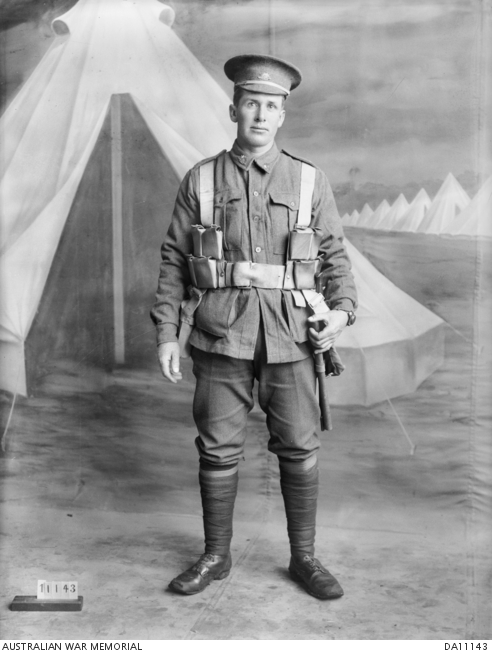
Clifford is Lance Corporal, later Sergeant 2237 Arthur Clifford, a single farmer from Banyena Victoria, where he was born on 27 October 1887. He had won a MM for gallantry at Fleurbaix and Pozieres. He returned home in August 1917, after being wounded in the left arm at Bullecourt, and passed away at the age of 93 on 29 September 1981.
Keig is 1533A Lieutenant Robert Leslie Keig, single draper from Williamstown, Victoria where he was born on 24 March 1888. He returned home after the war and was still alive in 1962.
Lieutenant Fethers is not Lieutenant Colonel Wilfred Kent Fethers, CO of the 23rd and previously of the 24th battalion. He is 792 Percival George Denton-Fethers, a single pastoral student from Preston, Victoria and born at Cranbourne in 1895. He was killed on 3 May 1917 and has no known grave.
Sid Butcher is 3708 Sydney Jackson Butcher, a single labourer from Berrigan, NSW where he was born about 1896. His mother was Mrs A Butcher. Sid was actually the brother who returned to Australia, not Jack. So Mum Smythe had the brothers mixed up.
Jack Butcher is 599 John Samuel Butcher, the older brother, having been born at Port Adelaide, Sth Australia in 1891. He was a single chauffer on enlistment. He was killed on 3 July 1916 at Pozieres and has no known grave.
Episode 2.29 “Death of a brother” Listen
Mal Meredith is 904736 Malville Nash Meredith, a single musician from South Edmonton, Alberta. He was born at Grand Forks, North Dakota, USA on 14 July 1894. He enlisted in the Canadian Expeditionary Force on 14 March 1916 and was in the 194th later taken on strength of the 10th Battalion, CEF in France on 27 April 1917. He was wounded in the left forearm, hand and thigh on 18 August 1917 and was returned home to Canada on 26 June 1918.
Thompson is Corporal, later Lieutenant, 1892 Czar Thompson, a single draughtman born at Jerrys Plains, NSW in 1896. He was shot in the arm at Lone Pine and he had been in Bulford Hospital with VD. He returned home in 1919 and was living at Granville NSW in 1963. He passed away in 1977.

Bob Mara is Sergeant Robert Spencer Mara (553) a single labourer, born in South Australia in 1884.
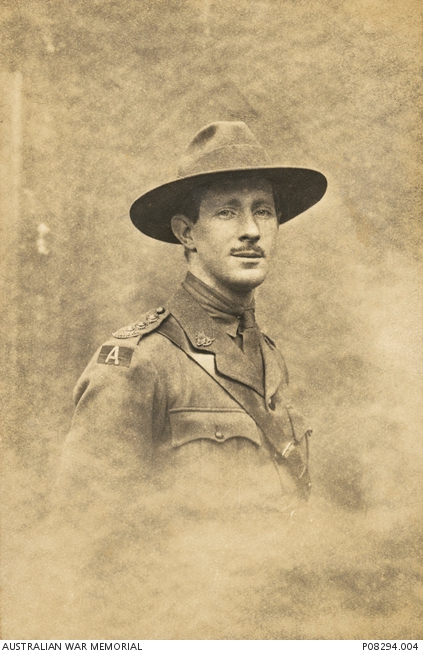
Mr McDermid is Captain 881 Albert George McDermid, a single engineer from Campsie and an original enlistment with rank of Sergeant to the 3rd Battalion in August 1914. Born in Sydney on 9 November, 1893. He was wounded at Lone Pine and recommended for a Military Cross at Proyart in 1918. He returned home in 1919 and worked as a stock inspector at Casino, NSW until re-enlisting in WW2 as a Flight Officer in the RAAF, but served at air bases around south eastern Australia. He was described in 1944 as not popular with his fellow officers due to a super zealous attitude. He was living at Surfers Paradise, Qld in 1967.
Captain White is Captain Stephen Frederick Paul White, a single farmer from Cootamundra NSW when he enlisted as a private in August 1914. Born 18 February 1895, he rose quickly through the ranks being commissioned in late 1915. “Paul” as he was known, returned home after the war and passed away at Moruya NSW in 1964 after having also served in WW2.
Lord Derby was the Secretary of State for War in the Lloyd-George Government. Edward George Villers Stanley, the 17th Earl of Derby had seen service in the Boer War rising to the rank of honorary Colonel.
Corporal Babb is Corporal later Sergeant 1138 Charles Reginald Babb, previously of the 18th Battalion, a married carpenter from Katoomba NSW, born at Bideford Devon, England in mid 1891. He had been wounded at Gallipoli and Pozieres. He was killed in action in May 1918 at Corbie. He is buried at Heilly Station Cemetery.
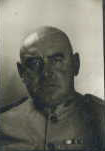
C.S.M. Garrick is Warrant Officer 2nd Class Keith Hannell Garrick, a married chemist from Collingwood, Victoria, born at Newcastle NSW on 27 September 1889. He was wounded in April 1917, initially assigned to the 6th Division but returns to Australia in November 1917 with rheumatism. He re-enlisted in WW2 as a married commercial traveller from Rose Bay, NSW and served at garrison posts around Sydney.
Episode 2.30 “Percy finds a jewel” Listen
Captain RC Anderson is Captain Robert Christian Anderson, a single bank clerk from South Brisbane, Qld. He was born at Newcastle NSW on 12 March 1894 and enlisted in May 1915. He was wounded on 28 August 1915 at Gallipoli while in the 17th Battalion, to which he would return in late 1917. Before returning home he transferred to the Indian Army and between the wars he worked as a civil servant. He re-enlisted for home service in WW2, reaching the rank of Major and he died on 8 June 1955 after living some of that time at Fairfield, NSW.
The Colonel is Lieutenant Colonel William Kenneth Seaforth Mackenzie, a single Barrister from Sydney where he was born on 7 January 1872. He enlisted two days after the Anzac landings with the rank of Lieutenant Colonel. He won Distinguished Service Order, Order of St Stanislas (3rd Class with Swords), a Russian decoration for his work at Pozieres. He started as OC of 19th Battalion serving 3 months on the peninsula and finished in the 23rd Battalion, having been OC of 2nd Australian Base Depot at LeHavre in between. He was criticised for letting the men misbehave, go AWL and for the general condition of the camp. He returned to work as a barrister after the war until retiring in 1951. The Colonel passed away on 3 June 1952.
Captain Prior is Captain Claude Esdaile Prior, a professional soldier with the rank of Lieutenant, from Artarmon, NSW, born at Borrowa, NSW on 19 August, 1895. One of three brothers to serve, another also reaching the rank of Captain, this man had studied at Royal Military College, Duntroon before enlistment. He returned home after the war, served as a Brigadier and deputy assistant quartermaster in WW2 and passed away at Manly, NSW on 13 June 1954.
Corporal Levy is probably Lance Corporal David William Levy, previously of the 18th Battalion and a married labourer from Merrylands NSW. He was born in 1895, finished the war in the 53rd Battalion and returned home in 1919, having been wounded once.
The Duke of Connaught or Prince Arthur, is the seventh child of Queen Victoria and had recently been the Governor of Canada, at the time of the story.
Fred Riddell is Corporal 1991 Frederick Walter Riddell, a single draper from Lithgow, NSW, where he was born about 1892. Originally in the 18th battalion, he was in the 61st with Percy and later a Lance-Sergeant in the 18th Battalion. Fred died of wounds at Passchendaele on 10 October, 1917 and is buried at Lijssenthoek Military Cemetery in Belgium.
Episode 2.31 “Dodging Dorothy’s Dad!” Listen
Timothy Ryan is most likely Private 3934 Timothy Gross Ryan, a single farmer from Glen Innes, NSW, where he was born on 13 February, 1889. He had been in 20th Battalion before he was wounded in the back in August 1916. He went back to that battalion after the 61st in late 1917. He was wounded in the face in April 1918, returned back to his unit in July but sprained his ankle and was sent home in December.
Henrys is Corporal, later Sergeant 247/2674 Irving Robert Henrys a single labourer from Parkes, NSW, born at Bourke on 17 December 1896. He would have been with Percy in the 3rd Battalion earlier and that is also where he finishes the war as the lewis gun sergeant. He returns home and passes away on 5 June 1966 and is buried at Botany Cemetery in Sydney. Another interesting fact about Henrys is that he enlisted twice. He was discharged after being found guilty of stealing a leather bag from another soldier by the infamous Colonel Kirkland at Liverpool Camp in mid 1915. He re-enlisted in October that year.
Brown of the 7th Reinforcements is Private 2470 James Brown, a single stoker from Tallong, NSW, born at Montreal, Canada on 3 January 1881. He was wounded in the face on 22 October 1915, hospitalised at Malta and returned to Australia in March 1916. Although, back he went in October 1916, suffering a wound at Hermies in April 1917 and eventually sent home again in January 1918. He was living at Woollahra NSW in 1945.
Episode 2.32 “The party is over and so is the parting!” Listen
Major Steele is most likely Major Alexander Steele a professional soldier and former instructor at Duntroon and machine gun specialist. The only problem is that his service record shows him as being in France in the 11th Battalion at this time. He died at Broodseinde Ridge on 13 October 1917.
Sergeant Dykes is Sergeant 334 Thomas Arthur Dykes of the 23rd Battalion, a married painter from Abbotsford, Victoria, born at Semaphore, South Australia in 1883. He was charged with being AWL in October 1917 at Perham Downs. However, Sergeant Dykes won the DCM as follows:
“During the attack on Mt. St. Quentin on 1st September, 1918, when two platoon officers were wounded, he took command and led his men with great dash and determination under very heavy shell and machine gun fire throughout the two attacks on the village, The attack being held up, he made a most daring reconnaissance under extremely heavy machine gun fire, and gained much valuable information. He then led his men forward and cleared up the wood south of the village. He personally captured a machine gun, after killing the crew, and after passing through the village reorganised and led his party forward, in the face of heavy machine gun fire, to a trench commanding the village— a very fine feat of initiative and determination, Later in the day he again made a most valuable reconnaissance over an exposed position, and from the information gained was able to rush his part of the line forward to better ground.”
Tom Dykes returned home after the war and passed away on 17 March 1952.
The Handcocks of “Myrhee” are the sons of Harriet and Charles Handcock of Myrrhee near Wangaratta, Victoria. Two of their sons were killed during the war and three others came home with injuries. One young son and two girls were left at home. The parents were presented with a clock by the local council on Anzac day 1917, that being donated to the Wangaratta Historical Society in 1967 and is on display in the Museum. Charles died of disease in 1919 while in France and Albert was killed in May 1915 at Gallipoli, while William, Frederick, Joseph, Reginald and Richard returned to Australia. The 8th brother was probably Robert Handcock from South Melbourne. He also returned home.
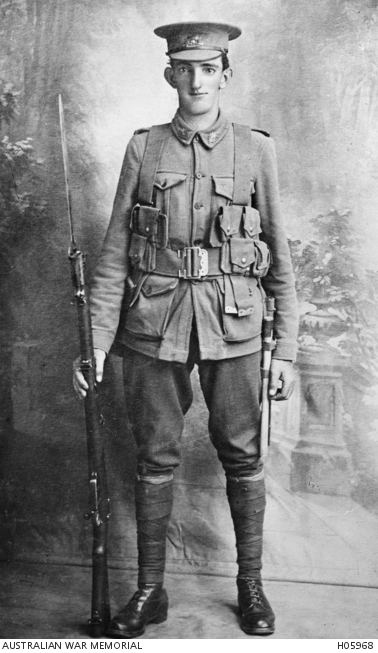
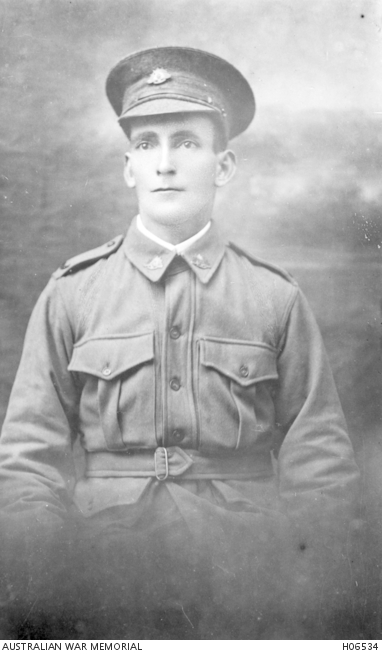
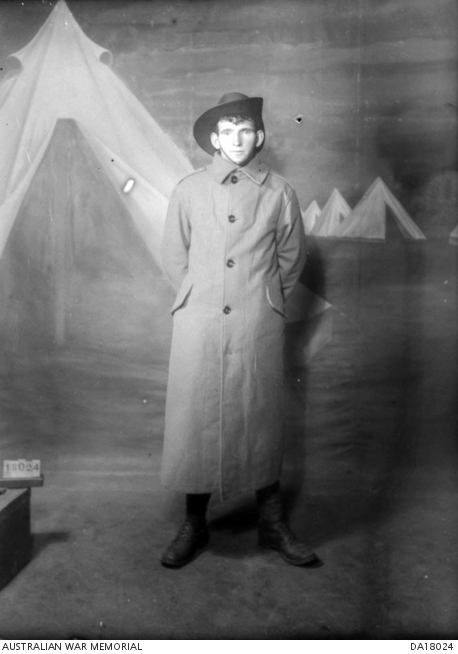 Albert, Charles and Fred Handcock
Albert, Charles and Fred HandcockThe four dead Captains of the 56th Battalion are George Elliott, Medical Officer and younger brother of Brigadier Pompey Elliott; Allan Chappell, the Battalion adjutant; Raymond Single (B. Coy); and Hubert Thompson (C. Coy). Vern Smythe was OC of A. Coy.
Episode 2.33 “Over the duckboards” Listen
Corporal Swetnam is Corporal 3978 Charles William Swetnam, a single labourer from Albury, NSW, born at Mount Lookout, Victoria about 1891. He had bronchitis on three occasions during the war and was discharged medically unfit with the condition in March 1919. He returned home but died on 22 August, 1924.
Sergeant Scrivener is Sergeant 279 Ernest Scrivener, a single painter from Williamstown, Victoria and born at Bridlington, Yorkshire, England about 1896. He survived 4 months at Gallipoli but only 10 days at Ypres, dying on 5 October 1917 at Broodseinde. He has no known grave.
Toohey is Sergeant 293 John Samuel Toohey, a single potter from West Brunswick, Victoria born on 23 June 1893. An original enlistment to the Battalion, he was wounded three times, the last time in the face at Montbrehain. He returned home in December 1918, married Daisy Langridge in May 1920 and passed away 6 January 1955. He is buried at Preston Cemetery.
Joe Osborne is Private 6554 Joseph Osborne, a single motor driver from Jerilderie, NSW. Joe was an Irishman, born at Bready near Londonderry in Northern Ireland about May 1888. He was killed on 6 May 1917 at Bullecourt, having only been in the 3rd Battalion since 17 March 1917. He had apparently been in Australia since 1912 and had only one known relative, so the Jerilderie people at least remembered him. Joe has no known grave.
W.C. Smith is Private 4197 William Charles Smith, a single painter from Collingwood, Victoria, where he was born in 1896. He had enlisted before but was discharged for stealing and he may have had an eyesight problem. He was taken on strength to the 24th in September 1916 but fell sick and ended up in England until October 1917. He was gassed in March 1918, returned to the Battalion in August and killed on 2 September 1918 and buried at Peronne.
Episode 2.34 “One grows callous” Listen
Sergeant Jim Collery is Sergeant 4388 James Michael Collery, a single labourer from Acheron, Victoria, born at Romsey, Victoria about 1895.
Sergeant Jolly is Company Quartermaster Sergeant 312 Victor James Jolly, a single ironmonger from Ballarat, Victoria where he was born in 1894. He had been a “Jack” when promoted to CQMS, then was slated for the 6th Division before he was transferred to the 24th Battalion on 3 November 1917. He was killed a few days after the Battle of Mont St Quentin on 7 September 1918 and is buried at nearby Peronne.
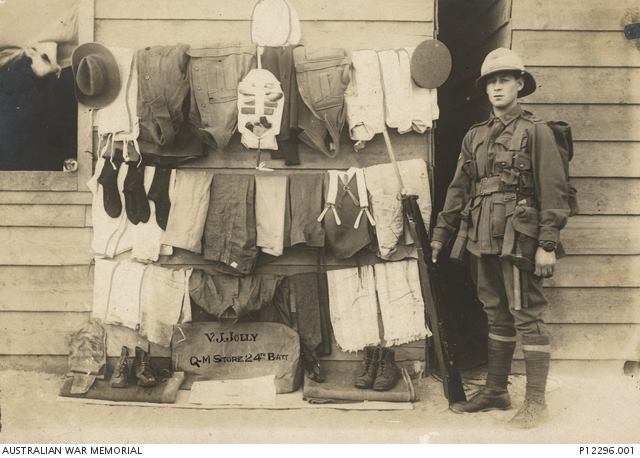
Rantman is Private 5708 Jakov Robert Rantman. He was killed on 4 October 1917 and is buried at Tyne Cot Cemetery. He was a single seaman born at Virve in Estonia about 1884. He left his estate to a Mrs Ottenson at Albert Park, Victoria but his next of kin was his father in Estonia.
Holyhead is Private 470 Charles Eric Holyhead, a single labourer from Malvern Victoria, born at Brunswick, Victoria supposedly in January 1898, but actually on 8 January 1900. He had already been evacuated with shell shock in December 1916 when in the 39th Battalion. Wounded again in March 1918 he was transferred to a gas training unit and eventually sent home in March 1919. He was living in Darwin in 1947 and 1948, when he managed the Darwin RSL and worked for the Territory Administration and died in Adelaide on 26 July 1962.
Terry is Private 6145 Thomas George Terry, a single porter from Narromine NSW, born at Westerham, Kent, England about January 1897. He only spent a short time with the 24th, transferring to 2nd Machine Gun Battalion. He returned home after the war.
Sergeant Way is Sergeant 4547 Leslie Gordon Way, a single farmer from Harkaway, Victoria, born at Carlton in 1893. He was wounded in March and again in July 1918 and returned home after the war. He was saved from a mad cow by 22 year old Elizabeth McPherson in 1943 and she was awarded a bravery medal.
Mr Middleton is Albert Edward Middleton, a single lawyer from Ballarat, Victoria where he was born on 24 November 1887. He returned home after the war and married Dorothy Ellen Rendell in February 1927. He was still practising law in 1953 from his chambers at 60 Market Street, Melbourne.
Goldsmith is Private 4422 Edward James Goldsmith, a single labourer from North Melbourne, born at Castlecomer, Kilkenny, Ireland in 1872. He had been in the battalion since September 1917, so only 2 months later he was officially wounded in the gas attack Percy described. He was returned to Australia in March 1918 and he passed away 7th July 1940 after living in North Melbourne.
Mr Noble is 2nd Lieutenant 575 Jack Noble, single clerk from Clifton Hill, Victoria, born 1894. He returned home after the war and also served in WW2.
Jago is Private 5944 Claude Melbourne Jago, a single bookbinder from Carlton, Victoria born about 1896 at Abbotsford. He returned to Australia in March 1918 after getting pleurisy in December 1918. Jago passed away on 22 April 1922.
Scholz is Private 1780 Walter Herbert Scholz, a single labourer from Antwerp in western Victoria who was born at nearby Rainbow in 1893. He was killed in action on 5 October 1918 at Montbrehain during the last major action by the AIF in the Great War. He is buried at Bellicourt Cemetery. His parents, Reinhold and Bertha Scholz, were possibly of German origin.
Mr Foster is Lieutenant John Foster, a married orchardist from Frankston, Victoria, born Dublin Ireland 21 October 1892. He had studied at Royal Military College, Sandhurst before emigrating. He enlisted in mid 1915, was at Gallipoli for a few weeks but suffered knee problems, returning briefly to Australia and only rejoined the battalion twice, the last being on 8th November, 1917, again suffering from knee problems shortly afterwards. He did some transport duty in 1919.
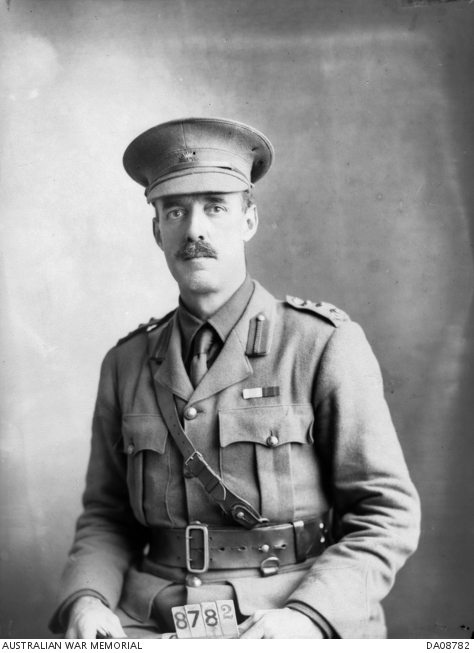
Major Smith is Major Harry Jacob Smith, a married professional soldier from Bentleigh, Victoria. He was born at Ryburgh, Norfolk, England on 11 February 1875 and enlisted as the Brigade Major for the 6th Brigade in March 1915. He had previously served with the 6th Dragoon Guards and saw action in the Boer War. An Anzac, he was evacuated with an unknown illness from Gallipoli where he had also been with the 21st Battalion. He was appointed OC of the 6th Training and 66th Battalions of the defunct 6th Division. He joined the 24th Battalion on 14 October 1917, but had already applied for discharge. He was sent home in early 1918.
Sergeant Westneat is Temporary Sergeant 3668 Alfred Courtney Westneat, a single commercial traveller born at Brighton Victoria in 1887. He returned home after the war and passed away on 20 February, 1960.
Episode 2.35 “A very manly letter” Listen
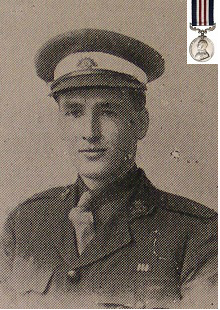
Bill Gibbs is Corporal 12301 William David Gibbs, a single school teacher from Maffra Victoria, born at Newry, Victoria about 1894. By this stage, he had already won the Military Medal while with the 33rd Battalion, as follows:
“On 31st July, 1917, near Messines, Lance Corporal GIBBS was in charge of a party of bearers working between a Regimental Aid Post and a Relay Post in an exposed area on the eastern slope of Messines Ridge. His party worked continuously over a shelled area and the routes of evacuation and in consequence to be continuously changed. This N.C.O. encouraged and helped his men, both by his presence and by his personal example, as he acted as a stretcher bearer on several occasions when the fire was hottest. His conduct throughout was exemplary and in addition to the qualities of personal bravery and devotion to duty, he showed a capacity for leadership and initiative of a very high order.”
He only gets to serve 12 days as an officer in July 1918 when he suffers burns to his hands and face and is eventually returned home to Australia in February 1919.
Episode 2.36 “The sports strike” Listen
Southey is Lance Corporal/Cadet, later Lieutenant 4606 Heber John Southey, a single surveyor from Melbourne, born at Shanghai, China around Christmas 1895, although he may have had his birth registered in Dartford England in 1896. His Dad lived in Dunedin, New Zealand, so itis presumed that they may have been English or Kiwi expats in Shanghai when he was born. With the 6th Battalion in 1916 and fated for the 6th Division in 1917, he ended up back in the 6th and was wounded in August 1918. He returned home after the war, getting into trouble holding fake leave passes.
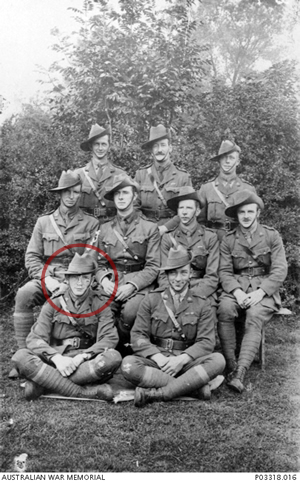
Caddy is Sergeant/Cadet, later 2nd Lieutenant 338 James Caddy, a single bushworker from Castlemaine Victoria, born in Melbourne in 1895. An original Anzac with the 6th Battalion, he won a Military Medal and a Distinguished Conduct Medal before being killed in action on 9 August 1918. He is buried at Heath Cemetery, Harbonnieres. Here is how he won his DCM on 4 October 1917 at Broodseinde,
“For conspicuous gallantry and devotion to duty. Although his left arm was rendered useless by a wound he remained on duty, as he knew the four platoon commanders of his company were casualties. When the second objective was reached he dug a strong point in front of it, and remained on duty until the battalion was relieved.”
Kennett is Lance Corporal Cadet, later Lieutenant 5733 William Kennett of 8th Battalion, a single grocer from Hamilton, Victoria, where he was born in 1895. He was wounded twice, once already in September 1917, but more seriously on 7th July 1918 when he was shot in the neck. He was described as having “spinal shock” but must have recovered. He passed away in 1969.

Major Rose is Major Alfred Barnes Rose, previously of the 1st Battalion, Manchester Regiment. He was born on 21 May 1879 at Wellington, New Zealand and died at Surrey, England on 20 November 1953. He was posted to 2nd Officer Cadet Battalion at Cambridge in 1917. He served as a Lt. in the 6th New Zealand Contingent in the Boer War and was recommended for a commission, as a 2nd Lt., in the Regular Army by the General Officer, Commanding in Chief, South Africa. The Major fought in Transvaal, Orange Free State and Cape Colony. After the war he served as an officer in Somaliland where he fought the infamous “Dervishes” in 1907 and 1908. He was gazetted 2nd Lt. into The Manchester Regt. on 27 July 1901. He was promoted to Captain in 1914 and despite not being considered fit for service, he took part in the 1st Battle of Givenchy in December that year.
Episode 2.37 “Viv sees King George” Listen
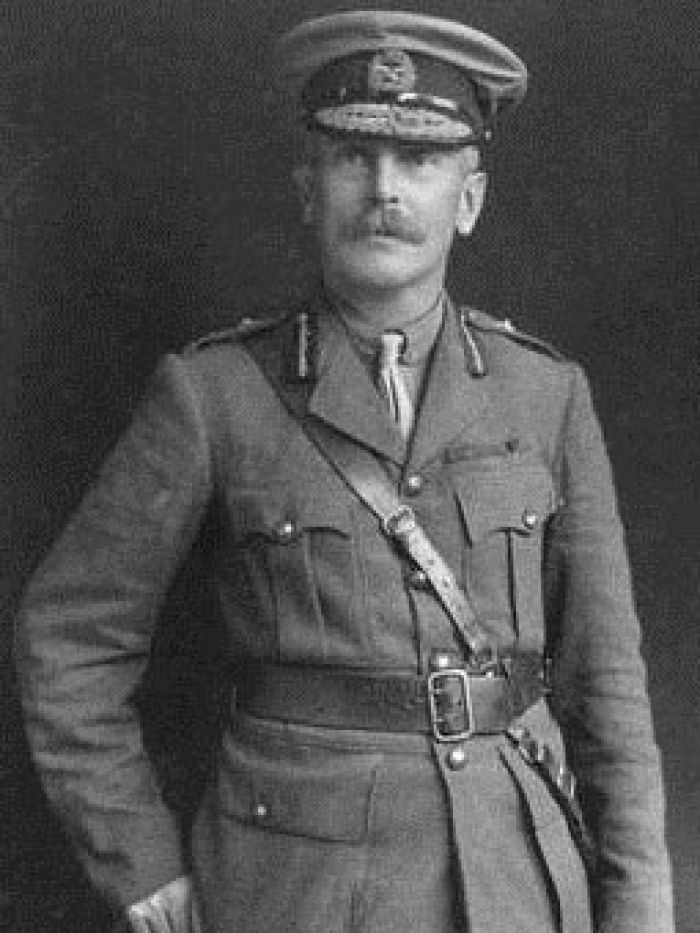
General McCay is Major General, later Lieutenant General James Whiteside McCay of Battle of Fromelles fame. Born at Country Antrim, Ireland on 21 December 1864, emigrating the following year. He studied at the University of Melbourne graduating in 1892, getting his Masters in 1894 and qualifying to practice law in 1897. He had also owned and taught at a private school, won a seat in the Victorian Parliament in 1895, which he lost in 1900 and then sat in Federal Parliament from 1903 until being defeated in 1906. He was Minister for Defence for a short time. He had been an officer in the reserve units from 1886, with the rank of Lieutenant-Colonel in 1900. At the start of WW1, he was one of the few men in Australia who recognised the war would be a, in his words, “titanic struggle”. He commanded the 2nd Brigade, AIF at the Gallipoli landing, later suffering a bad leg wound at Krithia. Sidelined in Australia due mainly to his injury, he was finally appointed commander of the 5th Division in March 1916. Then there was Fromelles. The planning was woeful, objectives irrelevant and artillery preparation ineffective. The 5th was also teamed up with the ill-prepared and understrength British 61st Division. McCay was blamed by many for exacerbating the losses (5,333 casualties in the 5th Division alone) but it may not have been his fault. Quoting the Australian Dictionary of Biography, “McCay had made only one conspicuous mistake in ordering his men to vacate the first trench after clearing it. He also had Colonel Pope sent back to Australia for alleged drunkenness; Pope was probably merely totally exhausted. Once again McCay was widely blamed by his men for the defeat, but the A.I.F. commanders knew the responsibility was not his.”
It appears he was also unpopular with men ranked just below him as well as the enlisted men. He was relieved of his command and at the time of Percy's writing, he was in command of AIF base depots in England. He was knighted at the end of the war, demobilised with the rank of Honorary Lieutenant General and passed away on 1 October 1930.
Mr Kerry is Lieutenant Arnold John St Legier Kerry of the 16th Manchester Regiment. He died on 14th February, 1918 at Burrell’s Walk Hospital, Cambridge. He was born at Dacca, India in 1893 or 1894 and was living at Gloucestershire prior to the war. He received a head wound at the Battle of Trônes Wood and is buried at the Cambridge City Cemetery.
Episode 2.38 “A traitor and mongrel” Listen
Dud Elliott is 6334/807 Private/Cadet later 2nd Lieutenant Dudley Marwood Elliott, a single timber hewer from Armadale, Victoria born at Brighton, Victoria in early 1895. This original 12th Battalion Anzac was evacuated from Gallipoli in July 1915 and was sent home to Australia later that year with enteric fever. He reenlisted and embarked from Freemantle in September 1916 and is taken on strength by the 11th Battalion in January 1917, spending the next 10 months with them. After attending OTC, Dud returns to the 11th Battalion in July 1918 and is shot in the thigh on 18th September 1918 at Roiselle. He died of his wounds later that day and is buried at Tincourt New British Cemetery.
Stevenson is Vere Cumming Stevenson, a single labourer from Black Springs via Oberon, where he was born about 1891. Already a Military Medal winner, with the following citation:
"For conspicuous gallantry and devotion to duty Battle of YPRES (Phase 5) 12th October 1917. When all Officers of his Company became casualties he organised the Company and carried on fight. He was one of the party detailed by an officer to capture a strong point, which yielded 4 machine guns and 35 prisoners in an attack on a second strong point after the officer had been killed, he assisted the Sergeant to organise the party and captured the post of 2 machine guns and 30 prisoners. After the Company had dug in on the new line he organised a ration party and succeeded in getting rations forward to the Front Line troops through a heavy barrage."
He was killed on 14th July 1918 and is buried at Villers Bretonneux. Two brothers were also killed in the Great War, one, Edward Lancelot Stevenson, in the Turkish attacks of May 1915, the other, James Garnet Stevenson, 10 days before the end of the war.
Episode 2.39 “Priceless Percy” Listen
Cadet Robinson is 5895 Corporal Cadet, later Lieutenant John Stephen Robinson, a married clerk from Waterloo, NSW where he was born on 25 March 1887. The Military Medal winner was wounded in the buttocks while with the 24th Battalion in September 1918. He returned home after the war and was living in Concord, NSW in 1962. He died on 4 December 1970 and is buried at Rookwood Cemetery.
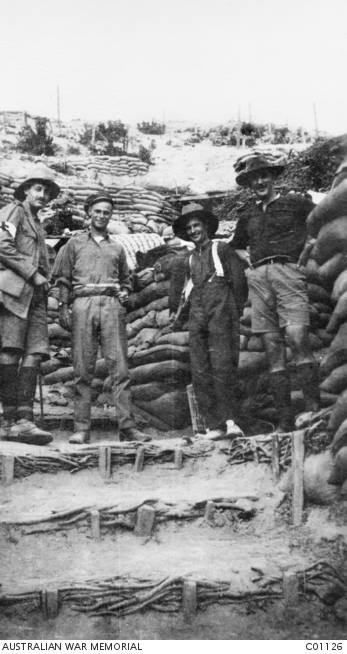 Norrie is on the right, photo taken at
Norrie is on the right, photo taken at
Courtneys Post, Gallipoli Colonel Norrie is Lieutenant Colonel later Honorary Brigadier in WW2, Edward Creer Norrie, a single architect from Rose Bay, born at Grafton, NSW on 28 September, 1885. He was originally a Captain in the AN&MEF in 1914 at Rabaul, later in the 19 Battalion in the Dardenelles and then put in command of the 25th Battalion in late 1916. Awarded the DSO in early 1918 and put in command of the 5th Training Battalion, which is where he finished the war. However, he did cross swords with General McCay and his Brigade Commander, who asked for him to be replaced in late 1918. Norrie asked for an inquiry into the matter and Lt-Gen John Monash recommended that Norrie not be returned to active service in the field. He returned home after the war with his English war bride, Jessie White. When he re-enlisted in WW2, his address was given as “Fovant” Pymble. He died on 8 March 1958.
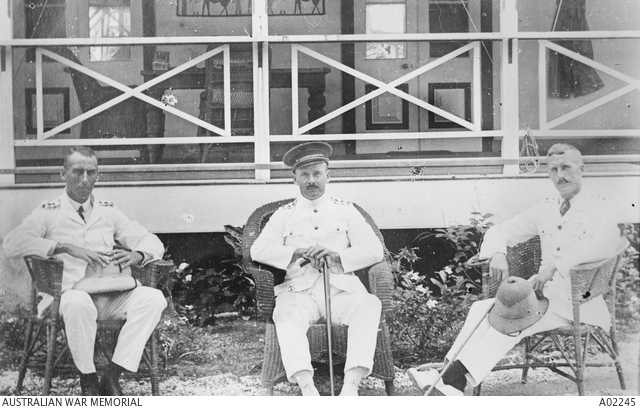
Hoskins is most likely Corporal/Cadet later Lieutenant 2091 Edwin Darlison Hoskins of the 44th Battalion, a single station manager from Mitchell, Qld, born in London, England on 26 July 1886. He was shot in the thigh in August 1918 at the Battle of Hamel and returned home in July 1919. He died in Cairns, QLD on 4 June 1968 and is buried in the Cairns Cemetery.
Episode 2.40 “Battle of Hamel” Listen
Captain “Tonto” Ball is Captain 377 Adrian Albert Ball, a single broker from Elsternwick Victoria, born on 28 June 1892 at South Yarra, Victoria. He enlisted in March 1915, arrived at Gallipoli in late August, won his DCM the following year at Pozieres for gallantry as a machine gunner. He was commissioned shortly after, quickly rising to Captain. Tonto returned home, and re-enlisted in WW2 as a Major. In civilian life, he was a journalist, mostly covering sporting events from England in the post WW2 era. Tonto died in England in early 1965 and is buried at St. John-at-Hampstead Churchyard, Camden, England.
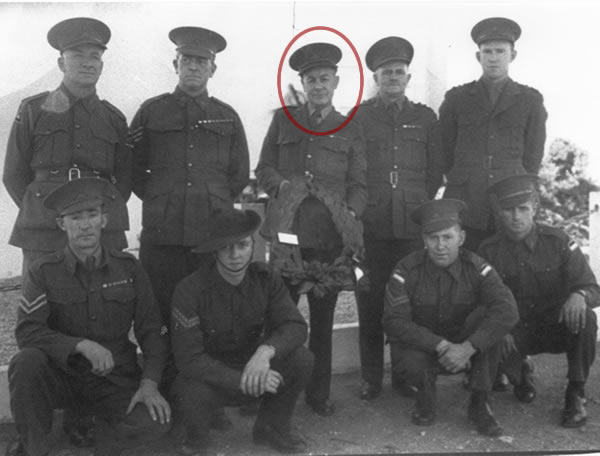
Captain Ball’s brother is Private 17081 James Percival Ball of the 7th Field Ambulance, not the 6th as Percy wrote. He was born at Elsternwick, Victoria in 1897, and was a single porter with the Victorian Railways on enlistment. He was killed on the 4th July 1918 having been hit in both legs by a shell and is buried at Beacon Cemetery, Sailly-Laurette, France.
Captain Menzies is the older brother of soon to be Prime Minister, Sir Robert Menzies. Captain Frank Gladstone Menzies, a single civil servant with the Crown Solicitor’s Office, from South Yarra, Victoria was born at Ballarat on 3 January 1892. Commissioned on enlistment in 1915, he made it through the war and returned home in 1919. As Crown Solicitor for Victoria, a job he held between 1926 and 1954, he was awarded a CBE on 1 January 1951. He died on 31 August 1978.
Colonel James is Colonel William Edward James. Billy James was born at Harcourt Victoria on 12 April 1882 and was a farmer before the war. Heavily involved in the Militia, as a Captain and area officer, he finally was allowed to enlist in 1915, was quickly promoted to Major and then took command of the 24th in July 1917. He won a DSO at Passchendaele and bar at Montbrehain. He returned home in 1920, re-enlisted in WW2 to command a training Brigade and passed away at Whittlesea on 26 September 1954.
Private Smythe is possibly Private 6897A John Bancroft Smythe of the 24th Battalion, a married tram driver from Miranda, NSW, born Blackpool, Lancashire England about 1890. He enlisted at Claremont Tasmania and probably lived there before the war. He returned home after the war.
Sedgwick is Lieutenant 747 Albert Victor Sedgwick, a single timber clerk from Geelong, Victoria. This Anzac was born at Ballarat, Victoria in 1893. He won his Military Cross at Mont St Quentin. He returned home and was still living in Geelong in 1967 and was buried at Fawkner Memorial Park in northern Melbourne on 3 July 1979.
Clough is Lieutenant 611 Horace Webster Clough, Military Medal and Military Cross, a single butcher from Williamstown, Victoria. This Anzac was born at Swan Hill, Victoria about August 1892. His brother was killed on 2 September 1918. He returns home, marries and lives at Daylesford, Victoria, where he passes away on 14 August 1959.
Roy Boyd is Lieutenant 375 Cecil Roy Boyd, a single farmer from Stavely, Victoria. He was born at Geelong about February 1895. Roy returned home to Australia in March 1919 and passed away on 28 January 1952 at Braybrook, Victoria. This Anzac originally with the 4th Light Horse, was mentioned in despatches as a sergeant, a rare occurrence.
Captain Mahony is Captain John Austin Mahony, a single clerk from Parkville Victoria, born late 1893 at Northcote Victoria. This Military Cross winner was shot in the head by a sniper on 5 October 1918 at Montbrehain and died on 9 October 1918. He is buried at Tincourt New British Cemetery. Austin enlisted with his best mate from school, Captain John Harry Fletcher. Sadly, Harry was killed the same day as Austin was mortally wounded. The boys commanded A and B Companies of the 24th when killed.
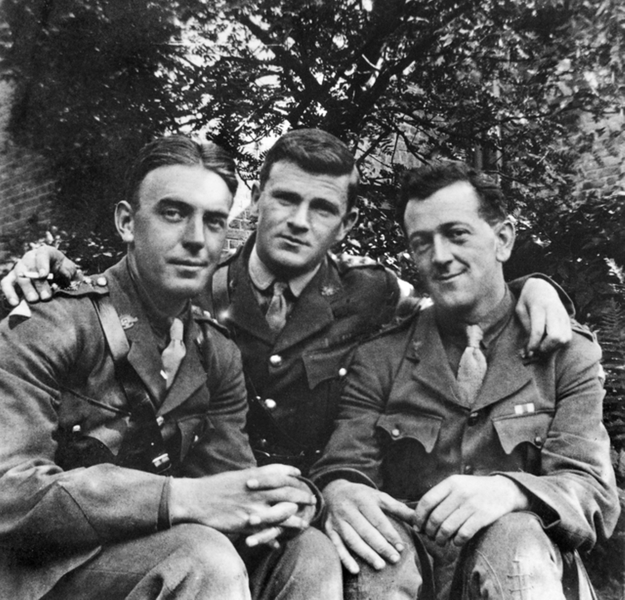 1918 - France - L-R: 1057 Captain John Harry Fletcher MC, of Eaglehawk, VIC; Lieutenant Joseph Lindley Scales, of Mitta Mitta, VIC; and 1056 Captain John Austin Mahony, of Hansonville, VIC -
1918 - France - L-R: 1057 Captain John Harry Fletcher MC, of Eaglehawk, VIC; Lieutenant Joseph Lindley Scales, of Mitta Mitta, VIC; and 1056 Captain John Austin Mahony, of Hansonville, VIC -
all officers of the 24th Infantry Battalion. 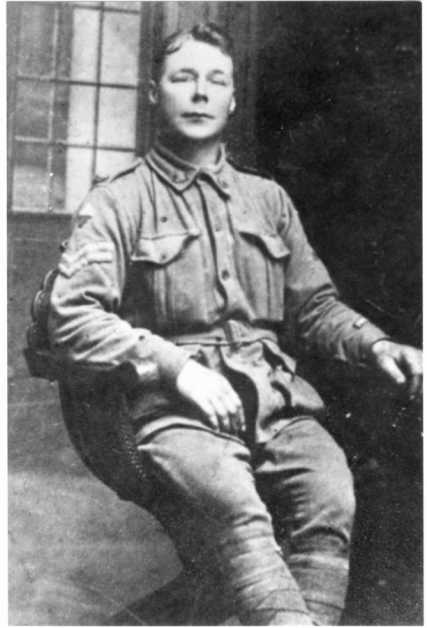
Corporal Holloway is Corporal later Sergeant 2487 Ernest Holloway, a married fisherman from Middle Brighton, Victoria. He was born at Richmond, Victoria about 1886. He married Anne Wilson in 1907 and had 5 children, four girls surviving by the time the war started. He enlisted in mid 1915 and won a DCM at Mont St Quentin on 1 September. Holloway was wounded 5 times during the war. He was one of three 24th Battalion sergeants (Storer and Bond) charged with “neglect to obey” while trespassing and illegal shooting of game, a deer, in the estate of one Comte d’Oultremont on 22 January. Two of them had German pistols when discovered by the gamekeeper. They did not obey the commands of Lieutenant McLean to stop trespassing and hunting. Their promotions to Sergeant were moved forward to September 1918. He was gassed in May 1918 and discharged in September 1919 with bronchitis. Holloway passed away on 9 February 1921 at Melbourne Hospital.
Lance Corporal Pahl is Lance Corporal 5070 David May Pahl. He was a single farmer from Ullswater Edenhope, Victoria, born at nearby Aspley about 1897. Dave was wounded once during the war, in the left buttock. He returned home after the war took up a soldier settlers block and passed away at Edenhope on 11 January 1966.
Lance Corporal Ansell is either 138 Charles Richard Ansell or 2107 Harold John Ansell a labourer from Swan Hill, Victoria.
Gordon Breen is 2nd Lieutenant Gordon Breen of the 23rd Battalion, a single blacksmith from Camperdown, Victoria where he was born about 1893. An Anzac, he was also wounded by a bayonet on 5 March 1917. This Military Medal winner was killed in action on the 4th July 1918 and is buried at Villers-Bretonneux Cemetery. He had won his military medal for putting out a fire in an ammo dump while it was being shelled.
Lees is most likely Private 1686 James Henry Lees, a single pawnbroker’s assistant born at Sheerness Kent, England in early 1896. He had quite a bit of illness early in the war but spent most of 1918 with the battalion. He returned to Australia after the war and was living at St Kilda in 1922.
Frith is Private 5171 Herbert Frith, a barman from East Melbourne, born at Williamstown Victoria on 3 April 1884. He was wounded three times during the war, including a gunshot wound to the thigh on 4 July 1918. He returned home in early 1919 and died on 25 March 1934, possibly at Prahran and is buried at Fawkner Memorial Park.
Fischmann is Private 6801A Carl Christian Fischmann was born at Copenhagen, Denmark on 8 January 1888 In 1915 he ws married to Helga and running a farm in Carrum, Victoria. After being shot in the back, he rejoined the battalion in October 1918. He returned home after the war, died on 21 October 1972 and was cremated at Altona Memorial Park.
Lance-Corporal Rowlands is later Corporal 2208 James Dixon Rowlands, a single clerk from Kew, Victoria, born at Hawthorn in 1895. He was wounded at Moquet Farm in August 1916, took over a year to fully recover and was later killed on 5 October 1918. He was buried at Calvaire Cemetery, Montbrehain.
Sullivan is Private 286 Daniel Francis Sullivan a single labourer from Strathmerton, Victoria where he was born on 2 July 1896. He enlisted in March 1915. He was wounded by a bayonet at Pozieres, a shell at Moquet, gunshot at Passchendaele and gassed in March 1918. He is buried at Péronne.
Episode 2.41 “Ludendorffs black day” Listen
Mr Baldock is Lieutenant 2117 Eric Sullivan Baldock, a single station overseer from Melbourne. He was born in Bombay (Mumbai), India on 22 May 1897. He won the Military Cross as a newly commissioned officer at Bapaume on 29 March 1917. He returned home after the war, married and re-enlisted for home service in WW2 without commission. He died at Heidelberg in 1967.
Roy Foster is Private 6097 Royal Raymond Foster, a single sheet metal worker from Leichhardt, NSW born in Sydney in 1893. His next of kin was his sister, Elsie. Roy was killed in battle on 20 August 1917 and is commemorated at the Menin Gate at Ypres in Belgium.
Episode 2.42 “Percy takes some prisoners” Listen
Sergeant Webb is Sergeant 5908 Charles Joseph Webb, a married farmer from Arawatta, Victoria. He was born at Shepparton in 1894. He returned to Australia in 1919 after being wounded twice during the war.
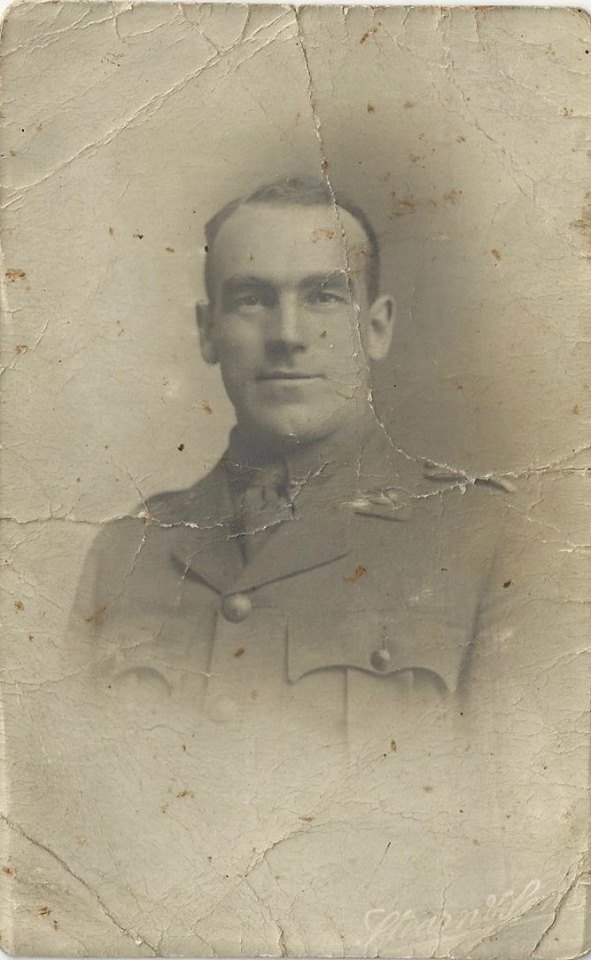
Baldie is 6772 Lieutenant William David Baldie, married farmer from Thorpdale, Victoria, born at Princes Hill, a Melbourne suburb. He was killed in action on 5 October, 1918 at Montbrehain and is buried at Calvaire Cemetery. Corporal Frank Saffin described his death as follows, “we were advancing on the extreme left flank on the outskirts of the village, when a shell burst right amongst several men of his section including Lieutenant Baldie, a piece of shell hit him on the head and he was killed instantly.”
Episode 2.43 “The Battle of Mont St Quentin” Listen
Lieutenant Jack Newton is 2nd Lieutenant 4743 Clarence John Raymond Newton, a single clerk from Horsham, Victoria where he was born in 1893. Newton enlisted in early 1916, and was commissioned in May 1918. He is buried at Péronne Communal Cemetery Extension.
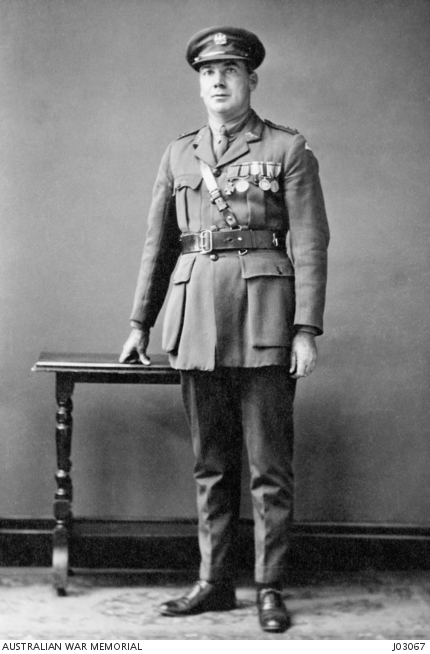
George Ingram is Lieutenant 5919 George Mawby (or Morby) Ingram. He was born on 18 March 1889 at Bendigo, Victoria. A married carpenter, he enlisted in January 1916. His VC:
“For most conspicuous bravery and initiative during the attack on Montbrehain, East of Peronne, on 5th October, 1918. When early in the advance his platoon was held up by a strong point, Lt. Ingram, without hesitation, dashed out and rushed the post at the head of his men, capturing nine machine guns and killing 42 enemy after stubborn resistance.
Later, when the company had suffered severe casualties from enemy posts, and many leaders had fallen, he at once took control of the situation, rallied his men under intense fire, and led them forward. He himself rushed the first post, shot six of the enemy, and captured a machine gun, thus overcoming serious resistance.
On two subsequent occasions he again displayed great dash and resource in the capture of enemy posts, inflicting many casualties and taking 62 prisoners.
Throughout the whole day he showed the most inspiring example of courage and leadership, and freely exposed himself regardless of danger.“
Courtney is Lieutenant Placid Aloysius Courtney, a single journalist, born North Sydney, NSW in late 1886. He returned home, was sued for not paying a hotel bill at Taree NSW in 1937, may have been a tax agent in Sydney in 1940 and was living in Melbourne in 1962.
Mr Wells is Lieutenant 24 Richard John Wells, a single farmer from Toolamba Victoria, born about 1895 at nearby Murchison. He returned home and passed away at Tatura, Victoria in 1964.
Sergeant-Major Jock Love is CSM 6831A William Love, a married professional soldier from Bendigo, Victoria. He was born at Fordell, Fife, Scotland on 18 March 1875 and previously served for 21 years in the 2nd Bn, Black Watch, Royal Highland Regiment. He was initially a Staff Sergeant in Australia but enlisted in the AIF in late 1917 to serve abroad. He is buried at Péronne.
Richardi is Private 57 Robert Richard Richardé, although often going as “Richards,” as well. He was a married labourer and sailor from Mooroopna, Victoria born at Fulham in Essex, England about 1889. He reported to the Red Cross on the death of Jock Love, saying he had been talking to Love when a shell hit them both. This Anzac returned home after the war after being wounded 4 times.
Corporal Sammy Wood is Lance Corporal 4218 Samuel Wood, a single grocer from Burnley Victoria, born 3 January 1895 at Birmingham, England. He enlisted in late 1915, was wounded at Bullecourt. Thre are five different accounts of how he died, two by a shell, one by an MG and two by a sniper. Private AC Bennett’s account is probably the best as he claimed to have been beside him in Gottleib Trench before the hop-over. He said Sammy was sniped and did not speak after being shot. He is buried at Péronne.
Mr Martin is Lieutenant 7354 Ernest Milton Martin, a single clerk from Armadale, Victoria, born in Sydney in 1893. He was originally with the 2nd Casualty Clearing Station before being sent to Officer Training School in April 1917. Two brothers served, one was a captain in 23rd Battalion and the other a Lieutenant in 1st Machine Gun Battalion. He is also buried at Péronne, despite Percy’s comment that only his paybook was found.
‘Snowy’ Doble is Private 340 Charles Leslie Doble, a single wood turner from East Brunswick, Victoria, born at North Fitzroy in late 1893. Snowy enlisted in early 1915 but didn’t make it to Gallipoli. He was wounded in June 1916. Snowy was not a model soldier, he was AWL three times including an 11 day stretch from Christmas Day 1917. For that he got 28 days of Field Punishment No. 2 which involved being kept in irons or fetters for certain periods of the day. However, he was described by Lt Bill Gow as having been Captain Mahony’s runner and an exceptionally good one. Bill also said he had just rescued a comrade under fire before he was killed. Snowy is also buried at Péronne.
Private Ellen is Private 6307 Thomas Mockett Ellen, a single driver from South Melbourne born at Beechworth, Victoria in mid 1894. He enlisted in October 1916, was gassed in early 1918 and returned to the Battalion in early August. Several statements to the Red Cross Wounded and Missing Bureau on this man corroborate Percy’s account of the death of these men. Apparently, they had just marched into the trench and were building a dugout to shelter from the barrage when they were all hit. He is also buried at Péronne. Two cousins were also killed in action.
Private Martin is actually Lance-Corporal 4728 Hector William Martin, a single upholsterer from Flemington, Victoria. He was born at Williamstown, Victoria about 1891. He joined the Battalion in October 1916, was wounded at Bullecourt and killed at Mont St. Quentin. Also buried at Péronne.
Lance Corporal Robertson is most likely Lance-Corporal 1751 Raymond Wallace Robertson of the 18th Battalion. He is buried at Péronne.
Murray is Private 6853A Alex Murray, a single labourer from Melbourne, born at Stornaway, Scotland on 4 November 1893. He died of wounds to the head, legs and hands on on 1 September 1918 and is buried at Daours Communal Cemetery Extension.
Corporal Roff is 4762 Robert Roff, a married labourer from Northcote, Victoria. He was born at Hawthorn about 1883. Roff and his wife, Alice had 5 children. He enlisted in February 1916 was taken on strength in September 1916 and won the Military Medal at Daisy Wood near Broodseinde on 9 October 1917 where he neutralised an enemy post holding up his battalion’s advance. He is also buried at Peronne.
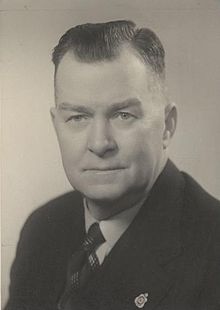
Captain Bowden is Captain George James Bowden, a married farmer, was born on 17 March 1888 at Moyhu, Victoria. He enlisted in March 1915, served at Gallipoli, was gassed and won a Military Cross for his work at Mont St Quentin. After the war, he became a stalwart of the Country Party. Initially serving as a Lieutenant Colonel in charge of a Garrison Battalion, he narrowly won the Federal seat of Gippsland in 1943. He held the seat until 1961, died on 8 June 1962 at the Repatriation General Hospital, Heidelberg, and was buried in Cheltenham cemetery. He was a solid rather than stellar parliamentarian. Rather than quoting his Military Cross citation, this political anecdote is from BJ Costar in the Australian Dictionary of Biography; “Gough Whitlam stated that he 'kept a good committee' and recalled that Bowden's impartiality waned only once when, carried away by a colleague's rhetoric, he interjected from the chair: 'Hear, hear!' Bowden quickly regained his composure and rebuked himself by calling: 'Order!'”
Gleadow is Lieutenant Hugh Allan Gleadow, a married accountant from Hawthorn Victoria. He was born on 2 September 1884, at Devonport, Tasmania. He served in the Tasmanian Rangers. He enlisted in October 1915 with the rank of 2nd Lieutenent, returned home after the war and passed away at Auckland New Zealand on 28 January 1955. He and wife, Annie had 5 children.
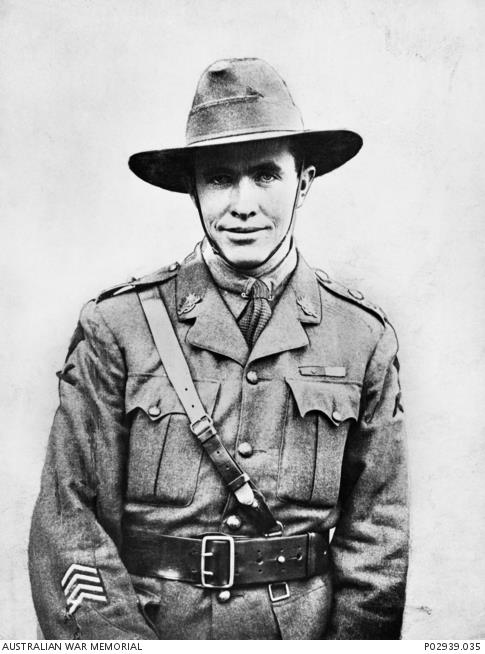
Mr Towner won a Victoria Cross for his actions at Mont St Quentin. He is 1067 Lieutenant Edgar Thomas Towner, a single grazier from Yalleroi, Blackall Queensland, where he was born on 19 April, 1890. He enlisted in January 1915, initially in the 25th Battalion and was in the 2nd Machine Gun Battalion when he won the VC:
“For most conspicuous bravery, initiative and devotion to duty on 1st September, 1918, in the attack on Mont St. Quentin, near Péronne, when in charge of four Vickers guns. During the early stages of the advance he located and captured, single-handed, an enemy machine-gun which was causing casualties, and by turning it on the enemy inflicted severe losses. Subsequently, by the skilful, tactical handling of his guns, he cut off and captured twenty-five of the enemy. Later, by fearless reconnaissance under heavy fire, and by the energy, foresight and promptitude with which he brought fire to bear on various enemy groups, he gave valuable support to the infantry advance. Again, when short of ammunition, he secured an enemy machine-gun, which he mounted and fired in full view of the enemy, causing the enemy to retire further, and enabling our infantry to advance. Under intense fire, although wounded, he maintained the fire of this gun at a very critical period. During the following night he steadied and gave valuable support to a small detached post, and by his coolness and cheerfulness inspirited the men in a great degree. Throughout the night he kept close watch by personal reconnaissance on the enemy movements, and was evacuated exhausted thirty hours after being wounded. The valour and resourcefulness of Lt. Towner undoubtedly saved a very critical situation, and contributed largely to the success of the attack.”
Percy, Lieutenant Courtney and Corporal Stonehouse were three men to write reports regarding this man’s actions, leading to the award of this VC. In addition to winning the VC, he also won an MC at Albert on 10 June 1918 and was mentioned in despatches twice. Wounded once, he returned home in May 1919 and passed away at the ripe old age of 81 on 27 August 1972. He is buried at Longreach, Qld.
Horrie Clough's brother is Private 7463 Edgar John Clough, a married postal worker from Darlinghurst NSW, born at Eaglehawk, Victoria in 1893. He enlisted in March 1917, was gassed in March 1918 is buried at Péronne.
Salmon is 2nd Lieutenant 6897 Percy William Salmon, a married grazier from Parkville, Victoria, born at Jeetho Victoria about 1887. According to Pte K Smallman, he was killed outright by a machine gun bullet, another man saying this happened at a sugar factory. He is buried at Assevillers New British Cemetery. He had a daughter born in 1909 with wife, Lily. He and Lieutenant Percy Baldie were remembered in the Argus in 1952 by Private Joseph Cotter.
Gilchrist is 2nd Lieutenant 471 Albert George Gilchrist, a single clerk from Mosman, NSW, born at Paddington, NSW about 1886. Originally in the Veterinary Section promoted to Sergeant, then an artilleryman, he was sent to officer Training Corps in late 1917. According to Captain Middleton, a German machine gun bullet hit a Mills bomb he had in his pocket, exploding it and killing him. He is buried at Assevillers. His brother Captain Walter Richard Gilchrist had been killed the previous year at Bullecourt.
McCarty is 2nd Lieutenant Patrick Thomas McCarty, a single farrier from Buninyong near Ballarat, Victoria, where he was born about 1892. He enlisted in July 1915 as a private and was Company Sergeant Major by August 1916. Wounded early 1917 and sent to Officer Training Corps in late 1917, he was commissioned in June 1918. He was shot in the neck, dying on the way to the Aid Post and is now buried at Péronne Communal Cemetery Extension. He was originally buried at “Lost Ravine” but the CWGC found the ravine when they were consolidating the cemeteries after the war.
Usherwood is Private 299 Frederick John Usherwood, a single labourer from New Gravesend, England, born in 1896 at Wrotham, Kent, England and arrived in Australia in 1913. He embarked to Lone Pine in May 1915 and was taken on strength to the 24th just after Moquet Farm. He was gassed in March 1918, wounded in the knee at Mont St Quentin and returned to Australia in 1919. He married Eleanor Woodward in 1924, had at least one daughter and died at Bairnsdale, Victoria in 1979.
Episode 2.44 “Fritz is on the run!” Listen
57 men from the 24th were killed on the 5th October and more died of wounds in the following days. A further 8 men died of illness in the last few months of the year, mostly from influenza.
General Rosenthal is Major General Sir Charles Rosenthal, born at Berrima, New South Wales on 12 February 1875. He trained as an architect in Melbourne, worked for the Dept of Railways and Public Works in Perth and served in the militia as an artilleryman. He was a keen musician playing the organ and bass singer. He mainly designed houses but also several churches including Holy Trinity in Dulwich Hill, which was commenced during the war and St Andrews in Lismore. Within the militia, he rose through the ranks to Major, just before the war and was appointed as commander of the 3rd Field Artillery Brigade at the outbreak of war. “Rosie”, as he was known by the men, personally sighted his guns at Gallipoli. He was wounded twice on the peninsula and again in late 1916. By mid 1917 he was a Brigadier in command of the 9th Brigade. Not known for taking a backward position, he was constantly in the front line and personally took prisoners twice, firstly at Passchendaele and again in March 1918. He was promoted to command the 2nd Division in May 1918 where he was in command for Mont St Quentin and Montbrehain. Knighted, awarded the DSO, French and Belgian Croix de Guerre and the Légion d’honneur. The end of the war didn’t stop him. He entered local and state politics, was a mover within the architecture profession, was the President of the Australian Museum and administered Norfolk Island during WW2. Rosie died from the effects of chronic nephritis on 11 May 1954 at Green Point near Gosford. He was cremated after a full military funeral at St Andrews Cathedral in Sydney.
Whitear is Lieutenant 1749 Arthur Edward Whitear, a single hospital wardsman, born in London, England about 1894. He enlisted as a private in June 1915, saw action at Gallipoli, was commissioned in May 1917 and won the Distinguished Conduct Medal, at Bullecourt.
“For conspicuous gallantry and ability in an attack. After all officers had become casualties, he assumed command of his company, and held the position until ordered to retire”.
Wounded twice and court-martialled for being AWL for 1 day, but only received a reprimand and loss of some pay. He returned home after the war and passed away on 15 August 1968 at Springvale, Victoria.
Corporal Stonehouse is Corporal 6390 Charles Samuel Stonehouse, a single farmhand from Garvoc, Victoria, where he was born about 1895. He enlisted in late 1916 and won a Military Medal at Mont St Quentin.
“During the attack on MT. ST. QUENTIN near PERONNE, on 1st September, 1918, this man did splendid work as a Sniper, and his coolness and courage did much to relieve the situation ever growing more serious. Casualties kept occurring and the enemy's numbers increasing, but STONEHOUSE remained undaunted. At great personal risk, for machine guns played all round him, he continued to fire, and accounted for from 15 to 20 Germans, he so seldom missed his mark that he appeared to demoralise the enemy, and thus did much to cover a temporary withdrawal of his section which was then taking place. Among his victims was a German whom he dropped from a tree, and who had caused our men much trouble”.
Stonehouse returned home after the war and passed away on 18 March 1960. He is buried at Ternang Cemetery in Victoria.
Cliff Ellis is Lieutenant 2036 Clifford Arthur Alfred Ellis, a single student from Collingwood, Victoria. He was born about March 1894 at Mitcham SA and enlisted as a private in June 1915. Cliff was recommended for a DCM at Pozieres but ended up with a MM instead. Shortly after he was commissioned. Cliff returned home after marrying an English girl and amongst other things he tried his hand at authorship. His description of the Battle of Montbrehain is from an unpublished book he wrote in 1934 called “Digger’s Story”.
“The breaking light again – the outlines of the village – the shells, the thickest of them fifty yards off. He looked to right – three men settled face down for all the world as though they had wearied and could go no further. He looked to left – and a man threw back his head and fell. The line had bunched, but it was coming on steadily, deliberately. He had the feeling again of living from second to second on slenderest sufferance.
The line was down now – two machine guns in potholes in the open – the duel cracked and rapped and hammered – a tank came up – waddling like a Christmas duck – officer in front – no mistaking the cut of that tunic he looked back at the tank and swung his walking stick – at the potholes – the Germans were up and running – the Lewis guns were at them – one-two-three, over they went and down to their soldier’s death instead of a worm’s”.
He passed away in 1983 at Cambrian Hill, Victoria.
Corboy is Private 6801 Phillip James Corboy, a single quarryman from Major Plains, Victoria, born at Benalla, Victoria on 29 September 1897, the oldest of 9 children. He was gassed in June 1918 and returned to the Battalion in August. He is buried at Peronne.
Coulsen is Private 6291 William James Coulson, a single labourer from Krowera, Victoria, born at Ballarat on 22 October 1892. He was wounded twice, third time he was killed. He is buried at Peronne.
Atkins is Private 2101 Frederick Augustus Atkins, a single carpenter from Oakleigh, Victoria. Born at Brunswick about 1893, he enlisted in July 1915. Between enlistment and embarkation he married Elsie Violet May Atkinson, whose father had been killed at Gallipoli on 11 May 1915. His father-in-law was an original enlistment to the 3rd Battalion and was probably acquainted, at least, with Percy’s brothers Bert and Vern. Fred never saw his only son, Keith, who was born in 1916. Fred was wounded at Moquet Farm and rejoined just before Christmas, going through all the battles of 1917 and 1918 without a scratch until Mont St Quentin. He is buried in Peronne.
“Tick” Taylor is Private 6141 James Taylor was a single labourer from Orange, NSW, born at Bathurst about 1897. He enlisted in September 16 and was gassed in March 1918, buried in Peronne.
Hildebrand is most likely Private 2156 Henry Arthur Hildebrand, a single plasterer from Westgarth Victoria, born at Collingwood on 19 June 1895. He returned home after the war and died on 5 June 1989 with a plaque at Fawkner Park Cemetery.
Lieutenant Gear is Lieutenant John Foster Gear. He was killed in action at the Battle of Montbrehain on 5 October 1918 and is buried at Ramicourt Cemetery.
Poor little "Russia" is Private 4363 John William Blankenburg. Russia is a single sailor who resided with a Miss Rosevear at West Brunswick. He was born at Riga, Latvia in 1892 and his mum may have still lived there at the time of his death, although Miss Rosevear believed his village had been destroyed in the war. Latvia was ruled by the Romanovs at that time of his birth, although Blankenburg is clearly a Germanic name not a Russian one. At the time of his death, the Germans controlled Latvia after the Treaty of Brest Litovsk.He was gassed in March 1918, when he won the Military Medal.
“In March 1918 he had been gassed when his 24th Battalion came under mustard-gas attack. Soon after rejoining his unit, he took part in the attack on Ville-sur-Ancre, near Albert, on the night of 19 May [1918], during which 'he showed a total disregard of all danger' and 'outstanding gallantry', according to the citation for his Military Medal. It stated: 'he was always found on the forefront of the fighting with his platoon officer. When the attacking party was temporarily held up and casualties inflicted by an enemy machine gun he threw a bomb into the post and then helped two of our wounded out of danger. When his party advanced again he helped his officer to rush another post, put the crew out of action and captured a gun.'
The same incidents featured in Bean's Official History: '[Lieutenant] Edgerton and his batman, a Russian named Blankenberg, at once threw bombs in the direction of the sound and half a dozen stick-grenades burst about them in reply. Four men were wounded ...'. Again, when 'Edgerton with his batman as companion' were out on reconnaissance, they came upon a German post; they 'had only one bomb left; but he took the chance, threw the bomb, and, under cover of its burst, dashed for the post. When he was five yards away the Germans began to put out their heads again. The first was shot by Edgerton and his Russian, and the remainder surrendered. ... Edgerton sent [back] the prisoners and the machine-gun in charge of Blankenberg.'
The citation also mentioned some additional mopping-up Blankenberg assisted in when daylight came up, which resulted in the capture of a second gun. Blankenberg had reason to be merciless towards the enemy, according to a letter he wrote to his Australian girlfriend: during the war one of his brothers, he said, was 'shot, another wounded, third and mother burnt, as their village was burnt'.
He was killed on 5 October 1918 and is buried at Calvaire Cemetery, Montbrehain, Picardie, France.
Snowy Lavery is Private 3947 John Joseph Lavery, a single printer from South Melbourne, Victoria where he was born in mid 1897. Fair haired Snowy enlisted in late 1915. He was killed in action at Montbrehain and is buried at Bellicourt Cemetery.
Bob Billingham is Robert Manning Billingham. He did try to enlist but he did not make it overseas as he was considered too young. He was born on 19 July 1900. His father did give permission, but his enlistment was cancelled.
Alec Stuart is Lieutenant Alexander Stuart, a single electrical engineer from Footscray Victoria, born on 12 August 1888 at Dunoon, Argyllshire, Scotland and emigrated in 1911. He was previously a Sergeant in the “Queen’s Own” Royal Glasgow Imperial Yeomanry, enlisted in July 1916 as a 2nd Lieutenant and returned home in 1919. He won a Military Cross at Mont St Quentin:
"For conspicuous gallantry and skill during the attack at Mont St. Quentin on 1st September 1918, when he led his company, in face of heavy opposition, and cleared the enemy out of their positions. His determination and courage in moving forward freely and amongst his command was a splendid example to all, and of great value in the operation."
He returned home, married Winifred Hunt at Heidelburg, Victoria in May 1920, had 2 sons, visited California in 1936 and died on 7 June 1965.
General Diaz is general Armando Diaz. He became the Chief of the Italian General Staff after the Italians rid themselves of the disastrous General Cadorna after the 12th Battle of the Isonzo in October 1917. Diaz reorganised the Italian Army and was able to repel the Austrians in early 1918 and then defeat them at the Battle of Vittorio Veneto in October and November 1918.
Captain Pollington is Lieutenant 1972 George David Pollington, a single grocer’s assistant from Clunes Victoria. Born on 29 April 1891 at Oakleigh, Victoria. Pollington enlisted in June 1915, won the Military Medal as a Sergeant in 1916 and was commissioned shortly after. He then won the Military Cross:
"During the operations before Beaurevoir, on 4th October 1918, he led his company with conspicuous skill and courage. He led an attack on an enemy machine gun post, captured four guns, and killed the garrison, nine in all. He took his objective and consolidated. Later, he led his men in attacks on enemy strong posts, and was severely wounded."
He returned home after the war served in WW2 reaching the rank of Captain in command of a POW Camp, and died at Heidelberg, Victoria on 29 July 1965.
Snowy Forbes is Lieutenant 1054 Ernest Lance Forbes, a single clerk from Brunswick born at Digby Victoria in August 1896. He enlisted in January 1915, was commissioned in August 1917. He had been recommended for a Military Medal for his work as a runner at Pozieres but was not awarded it. He had also faced a Court Martial for assaulting a Major. Snowy returned home in 1919, took a job as a bookmaker’s clerk but died quite young on 1 December 1924, the result of a bar room brawl at The Orient Hotel in Melbourne nine days earlier. A Francis “Lofty” Perkins was tried for manslaughter. Snowy, Lofty and two other mates were drinking together on 22 November, Snowy being quite intoxicated, when an argument broke out. Snowy may or may not have taken the first swing but he was pushed by Lofty, fell down and hit his head. Later that day, he absconded from the Melbourne Hospital with a fractured skull. A week later he became confused and friends took him back to the hospital. Coincidentally, on that same day Lofty committed what was to become known as the “Hampton Murder,” allegedly shooting a bank teller named William Almeida in a hold up. He was convicted in February and sentenced to 15 years jail with 3 floggings. The floggings were later dropped on appeal. The reports on the second trial for the manslaughter of Snowy could not be found but 15 years was the maximum sentence at the time. Snowy is buried at the Fawkner Memorial Park in Melbourne.
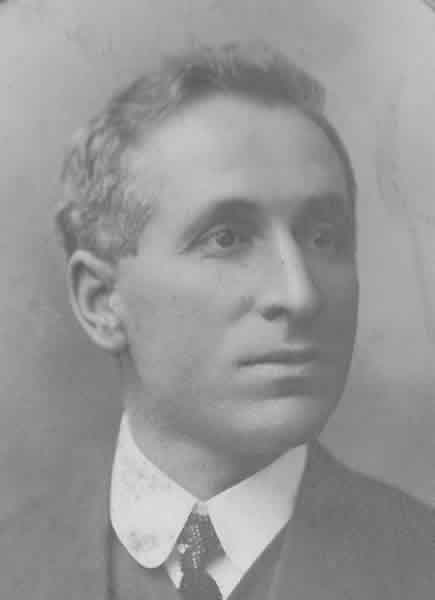
Joe Granter is Private 5452 Joseph Andrew Granter, a married insurance agent from Elwood, Victoria, born at Warrnambool 16 January 1878. He and wife Edith, who he had married back in 1899, had three sons between 1900 and 1904. Prior to enlistment, he was a Sergeant in a Depot Battalion, when in February 1916, he was charged and court-martialled for wearing officer’s stars. He enlisted as a private in May 1916, was commissioned for real in January 1917 and returned home after the war. He passed away at Prince of Wales Hospital, Randwick NSW on 18 March 1948.
Book is Lieutenant Horace John Book, a single elocutionist born Toxteth Park Liverpool, England, on 9 May 1887. He enlisted as a 2nd Lieutenant in January 1916, was wounded in May 1918 and returned home after marrying Mary Elizabeth Williamson Goodwin in 1921. He was an actor before the war and a grocer after, being in the Grocer’s Association for many years. He served on the Tea Control Board in 1942 and gave evidence at an enquiry into the selling of liquor from grocery shops in 1952, for which he was in favour. He died at Richmond, Victoria on 5 February 1955.
Episode 2.45 “Peace” Listen
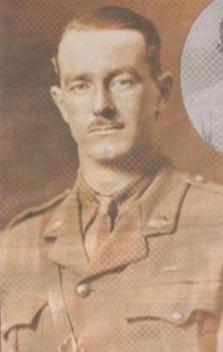
Colonel Massie is Lieutenant Colonel Robert John 'Jack' Allwright Massie, a cricketer left arm fast bowler who represented NSW in the Sheffield Shield and took 99 wickets in just two seasons. He also represented Australia against NZ, was an amateur heavy weight boxer and a hurdler. Jack was born on 8 July 1980 at North Sydney. At the time the war broke out, he was studying Civil Engineering at Sydney University but he joined up almost immediately and was commissioned as a second Lieutenant in the 4th Battalion. He returned home after the war and passed away on 14 February 1965 at Mosman NSW after working for British American Tobacco, W.D. & H.O. Wills and doing a stint on the Board of the old CBC Bank. His only son was killed in WW2.
Major Wilson is Thomas Charles Wilson who was born at Gibraltar on 30 August, 1877. He was a married military reserve officer and telegraphist from St. Kilda, Victoria on enlistment. He ended the war as Chief Instructor at the Australian Corps Signal School.
The Brigade Major is Major, later temporary Colonel, John James Lawton McCall, a professional soldier who was born in Newcastle, NSW on 8 May 1894. Enlisting in 1915 after graduation from Royal Military College, he was evacuated from Gallipoli, either wounded or sick and ended up first in Malta, then in Rome where he had an audience with the Pope but he was more intrigued with the Italian people. From a letter published in the Bombala Times:
“Last night one of the other officers in our party and I went out for a stroll after dinner, and found ourselves in the Piazza Collona, where the municipal band was playing. We were quietly and unostentatiously standing on the outside, when all at once we were spotted and surrounded by a cheering crowd. 'Viva Inglesi' they shouted, but gathering close round us they spotted the Australia on our shoulder straps, and then such a cheering and handshaking and cries of 'Viva Australiani';' they hissed the band to quietness by their shouting. The Carabineri came along, but no use. The crowd kept on, and pushed us right out into the front of the bandstand, where the glare of two big arc lamps shone full upon us, and then the whole crowd saw us and didn't good old Australia get a cheer. An officer came to us who spoke excellent English, and asked us who we were, and we quietly and modestly told him; but when he heard it from us that we were from the Dardanelles, he shouted it out, 'Feriti Australiani Dardanelli,' meaning wounded Australian officer , from the Dardanelles, with such an uproar. The crowd surged around us, shaking me almost to little fragments, and cried to the band to play - L'Aria Nazionale Inglesi,' or- something like that.”
He first served in 30th Battalion, then 20th Battalion as a Captain and adjutant, finally promoted to Major just after Mont St Quentin. He was mentioned in despatches twice and awarded the DSO. He was kicked by a mule in late 1917. He returned home after the war and lived at St Kilda Vic, Randwick NSW and Fawkner Victoria. He married Constance Wilson in 1922 and had 1 daughter. He wrote many articles on gas as Director of Civil Defence in the early days of WW2 and later served stints in New Guinea as a staff officer. He died on 3 January 1968.
Captain MacNeil is Captain Alexander Rowan MacNeil, a single ironmonger from Balwyn, Victoria, born at Hawthorn on 27 February 1894. He enlisted as a 2nd Lieutenant to the 21st battalion in mid 1915. He ended the war with a Military Cross and Bar, DSO and a mention in despatches. The DSO citation reads
"For conspicuous gallantry and devotion to duty. He handled his mortar with great courage and determination against an overwhelming attack. He held off the enemy with his revolver until his men had got the mortar away to safety. He then took part in the counter attack, and with great execution with a machine gun.'
That was at Broodseinde as it was gazetted in December 1917. He returned home and wrote the 21st Battalion official history. He served in WW2 as a Presbyterian Chaplain with the 2/29th Battalion in the Malaya Campaign. He was taken prisoner in the fall of Singapore and was chaplain at Changi POW Camp. He managed to survive and returned home in 1946. He served as a chaplain in the Citizens Military Force and passed away on 14 October 1953 at Kew, Victoria leaving a wife, Margaret and two children.
Captain Sale is Captain Frederick Sale, a single draftsman from South Yarra. He was born in Melbourne on 14 June 1892 and enlisted as a 2nd Lieutenant in the newly formed 21st battalion in March 1915. He won Military Cross at Pozieres and a bar to the Military Cross at Broodseinde Ridge on 4 October 1917. Fred returned home in 1919 and died on 28 July 1935.
Corporal Loveless is Corporal 5859 Albert Richard Loveless, a married clerk from St Kilda born nearby South Melbourne in 1895. He returned home after the war and he was still singing in 1945 when he performed in an Anzac Night Concert at the Footscray Royal Hall. He was a baritone.
Rickman is Lance Corporal 3238 Arthur Rickman, a single commercial traveller from Kew, Victoria. He was born about June 1888 at South Melbourne. He returned home in April 1919, moved to Bournemouth, England shortly after jilting a girl named Jessie Henderson, married a Constance Jones in 1921 and possibly died in 1959.
Newton Calvert is Lieutenant 607 Newton Rae Calvert, a single bank clerk from Hay, NSW, born at Ararat, Victoria about September 1894. One of the original enlistments he enlisted as a private, was wounded at Moquet Farm, commissioned in December 1917, promoted to Lieutenant in April the following year. He was mentioned in despatches. He returned home in March 1919, worked at a Bank and died on 9 April 1920 at Shepparton, Victoria.
Bert Baxter is Lieutenant 604 Herbert Baxter, a single farmer from Nagambie, Victoria, born about August 1882. He enlisted as a private was commissioned in May 1917, promoted to Lieutenant in April the following October. Wounded three times, he was also mentioned in despatches and returned home in March 1919 continued farming and died in 1958 with a wife and 1 daughter.
Hill is Lieutenant 2780 Edmund Adrian Durieu Hill of the 6th Field Company Engineers, a single surveyor from Grafton, NSW. He was born in St Leonards, New South Wales on 24 May 1892 and enlisted as a sapper in July 1915. He won two Military Medals before he was commissioned:
"During attack operations near WESTHOEK east of YPRES on 20th September, 1917, Lance Corporal HILL was one of a party detailed to mark out a communication trench immediately after the attack. Although wounded in the mouth by a shell shortly after leaving cover for the job, he only stopped to have the wound bound up and then proceeded after the party which he rejoined. A experienced surveyor, he was invaluable in assisting with the location and despite heavy barrage fire, carried on coolly, greatly assisting towards the successful siting of the trench."
He returned home on 13 April 1919 and passed away at Newtown, New South Wales on 27 April 1967.
Renshaw is Lieutenant Harold Conrad Renshaw, a single civil engineer from Roseville, NSW. He was born on 1 July 1893 and enlisted as a Lieutenant in late November 1915. Another Military Cross winner:
"For conspicuous gallantry and devotion to duty. After seven nights of work in heavily shelled and gassed areas, this officer undertook the strengthening of tunnels under a road to enable armoured cars to pass. He organized and guided a large carrying party under intermittent shell and machine gun fire, and got all materials up before dawn. Although suffering from gas, he continued at work all day and completed his task before dark. But for his resource and leadership the road would never have been ready for the cars to use in support of the attack."
He returned home in April 1919, married wife Amy later that year, had 3 children, served in the Volunteer Defence Corps in WW2 and lived at Hornsby NSW most of his life. He died on New Years Day, 1974 at Roseville NSW.
Davies is Captain Eowyn Hugh Davies of the 6th Field Company Engineers (sometimes recorded as Edwin) was a married Surveyor for Malvern Victoria born about 1892. In support of the 24th Battalion on 19 May 1918 he won a Military Cross:
“For conspicuous gallantry and devotion to duty. On two consecutive nights this officer was responsible for throwing the foot bridges across a river in "No Man's Land". The first night he organized the operation and his covering party so skilfully that two bridges were constructed and bridge heads established in one and a half hours. The second night he launches a bridge with sappers only, and, while on his way to launch the second bridge, suffered 50 percent casualties, but got the bridge launched and reported ready just in time for the attack to commence. Then he helped to carry his casualties to the regimental aid post."
He suffered from mental depression and committed suicide by ingesting strychnine on 11 November 1920 and is buried at Brighton Beach Cemetery in Victoria.
Episode 2.46 “Occupation” Listen
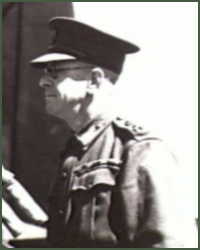
Captain Fewtrell is Captain Frederick Percy Herbert Fewtrell, a single engineering student from Kilkivan, Qld, born 25 June 1894. He enlisted as a 2nd Lieutenant in mid 1915, was wounded in the face at Bullecourt, was mentioned in despatches and returned home to Australia in April 1919. He served in WW2 with the rank of Brigadier, married Dorothy Hill in 1958, visited England the next year and passed away in 1964. He lived for some time at Artarmon, NSW.
Sexton is Lieutenant Clarence William Newsome Sexton, a single engineer born in Albert Park, Victoria in 1890. He enlisted in early 1916 and is down as having been in the 6th and 7th Field Company Engineers, although I doubt the latter, both units in the 2nd Division. He was wounded at Passchendaele, gassed possibly at Hamel and returned home in 1919. He was an expert witness in a manslaughter case in 1925 and passed away in 1973 at Hawthorn, Victoria.
Episode 2.47 “War Bride” Listen
The Reverend AJ Campbell is Andrew James Campbell born at Crathie, Aberdeen, Scotland 30th June 1875. He studied at Cambridge, graduating with a BA in 1897. He then worked as an Anglican Minister at Lerwick, Scotland between 1902 and 1909. In WW1 he served with the 1/5th Battalion Highland Light Infantry in the 52nd Division, seeing service throughout the Gallipoli campaign at Cape Helles and later in Egypt and Sinai. After the war, as well as being the Minister at St Johns, marrying the Smythes, he later received an MA at Edinburgh University. He also wrote “Church of Scotland History.”
Episode 2.48 “Everybody Loves a Parade” Listen
Episode 2.49 “Too-ral-li oor-ral-li addity” Listen
Fred Scales is Lieutenant 3826 Frederick Hudson Scales of the 1st Battalion, who enlisted as a single clerk from Leichhardt, NSW, born in London, England on 9 May 1884. Fred enlisted as a private in August 1915 and was commissioned in early 1917. Fred suffered an accidental gunshot wound in February 1917. Fred was a platoon commander during the Battle of Chuignolles and was able to affect a good advance during the fighting, according to the 1st battalion official history. Mrs Scales is Mabel Elizabeth Scales (nee Stuttle), the couple marrying on 3 April, 1917 at St Matthews in Stepney, presumably when Fred was recovering from his wound. Billy Scales is William Thomas Hudson Scales born at Salisbury on 22 February 1918. Fred and Mabel also had a daughter born in 1920. Fred passed away at Grafton NSW in October 1958.
Fred is not related to Joe Scales from Mitta Mitta, Victoria who also reappears in this episode.
The next three Kiwi soldiers played in the “Kings Cup” held in South Africa in 1919 between 6 competing teams including an AIF Team, Canadians, South Africans, two teams from the UK (Army and RAF) and the victorious Kiwis, although the Aussies were the only team to beat them in one game, the New Zealanders ultimately won the cup, which was awarded by the King.
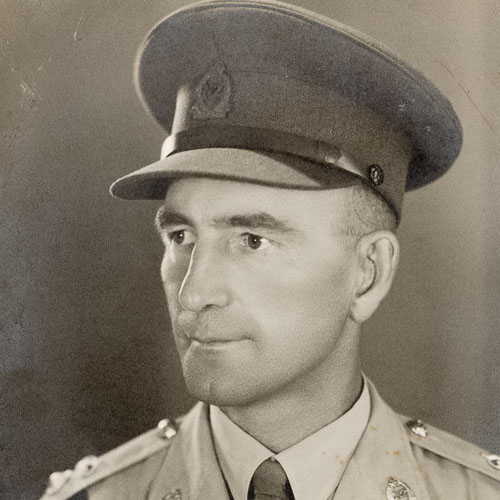
Lieutenant McNaught is 29697 2nd Lieutenant Gifford John McNaught of the Machine Gun Corps, a single student later a teacher, from New Dunedin born 26 January 1895 and enlisting in June 1916. Returning home, he married Mary “Molly” McQueen in 1926, the couple having 3 children. He served in Scotland and Egypt in WW2 and reached the rank of Lieutenant Colonel with the Wellington Regiment as CO of the 29th 32nd and 25th Battalions, winning a DSO. He was wounded in the legs in 1941 in Egypt and returned home to take up duties as Headmaster of a boys high school at New Plymouth where he lived until passing away on 1 June 1975.
Sergeant O'Brien is 26899 Sergeant John Gerald “Jack” O’Brien of the Divisional Signals. An All-Black in 1914 and again in 1920, he was born in Wellington on 9 December 1889. He is listed as a telegraphist from Morrinsville, Auckland on enlistment in June 1916. He played a total of 12 games as an All-Black, playing Fullback. The following is from the sporty.co.nz website, “Though only 1.73m tall and around 70kg O'Brien was noted for his courage on defence and under high kicks, for his dependability and sure positional sense. Such was his reliability that the Prince of Wales was reported to have commented "If I dropped my kitbag from the dome of St Paul's, O'Brien would catch it".” Jack passed away on 9 January 1958 at Morrinsville.
Sergeant Naylor is Sergeant 49510 Eric Joseph Naylor of the 2nd Battalion, Otago Regiment. He was mentioned in despatches. A farmer from Matakanui, Otago Central, he was born on 24 September 1896 and enlisted in February 1917. He was promoted to Sergeant in early 1919 when selected for the Kings Cup Team. He married Elizabeth Kirkaldy in 1924 and passed away on 15 September 1981.
Episode 2.50 “The Smythes” Listen
























 he was commandant at the Base Depot there at Perham Downs. He was sent from the front due to recurring bronchitis and asthma and eventually repatriated home in June 1918. He re-enlisted in WW2, with the rank of Brigadier. Sir George Knox, Victorian Parliamentarian from 1927 until 1960, was the speaker of the house in the 1940s, was living at Ferntree Gully, Victoria and died on 24 October 1960.
he was commandant at the Base Depot there at Perham Downs. He was sent from the front due to recurring bronchitis and asthma and eventually repatriated home in June 1918. He re-enlisted in WW2, with the rank of Brigadier. Sir George Knox, Victorian Parliamentarian from 1927 until 1960, was the speaker of the house in the 1940s, was living at Ferntree Gully, Victoria and died on 24 October 1960. 
 Antill is depicted in the 1981 film Gallipoli by Peter Weir. During the Battle of the Nek, on 7 August 1915, between 4.30 and 4.45am three successive waves of lighthorsemen were mown down during the attack on heavily fortified trenches which had been badly bombarded. The CO of the fourth wave, Lieutenant Colonel Brazier tried to have that wave cancelled but Brigadier Hughes and Major Antill failed to do so before many of the men went over the top. In fact, most accounts have Antill insisting that the attack continues. He was knighted after the war.
Antill is depicted in the 1981 film Gallipoli by Peter Weir. During the Battle of the Nek, on 7 August 1915, between 4.30 and 4.45am three successive waves of lighthorsemen were mown down during the attack on heavily fortified trenches which had been badly bombarded. The CO of the fourth wave, Lieutenant Colonel Brazier tried to have that wave cancelled but Brigadier Hughes and Major Antill failed to do so before many of the men went over the top. In fact, most accounts have Antill insisting that the attack continues. He was knighted after the war.



























